THE STATE OF CTV, DOOH


Why spending is surging in both media channels






SPECIAL REPORT


Examining the In-Store Shopping Experience (in collaboration with Great Northern Instore)



P2PI.com MARCH/APRIL 2023
MAR/APR 2023 P2PI. com




Hall of Fame 2023

Special Report: Examining the In-Store Shopping Experience










DOOH & CTV
The










P-O-P Showcase

Our latest display gallery presents a sampling of eye-catching and effective in-store activations, in the BevAlc category and beyond.

Path to Purchase Institute magazine (USPS 4568, ISSN 2835-0219) is published bi-monthly by EnsembleIQ, 8550 W. Bryn Mawr Ave., Ste. 200, Chicago, IL 60631. Subscription rate for the U.S.: $80 one year; $155 two year; $14 single issue copy (pre-paid only); Canada and Mexico: $105 one year; $185 two year; $16 single issue copy (pre-paid only); Foreign: $115 one year; $215 two year; $16 single issue copy (pre-paid only); $56. Periodical postage paid at Chicago, IL 60631 Copyright 2023 by EnsembleIQ. All rights reserved. No part of this publication may be reproduced or transmitted in any form or by any means, electronic or mechanical, including photocopy, recording, or information storage and retrieval system, without permission in writing from the publisher. POSTMASTER: send address changes to Path to Purchase Institute magazine, 8550 W. Bryn Mawr Ave. Ste. 200, Chicago, IL 60631. March/April 2023 VOLUME 36 | ISSUE 2 Contents P2PI.com FEATURES 14 24 36 40
Path to Purchase Institute shines the spotlight on this year’s honorees: executives from Crayola, Ulta Beauty and Conagra Brands.
The
research provides updated insights into shopping patterns, new areas of opportunity
that could influence future
Proprietary
and the factors
behaviors.
growth of digital-out-of-home
TV
and connected
advertising tells a story about how brands are adapting in the cookie-less, multi-device world.
COVER STORY
Editorial Advisory Board


















the Path to Purchase Institute
Contents 4 l March/April 2023
Follow
here:
Keith Albright Kimberly-Clark Dana Barba Coca-Cola North America
Paige
FIJI
Apple Travis Harry
Depot Brendon Lynch
Holdings José Raul Padron The Hershey Experience Jonny Rigby Amazon Jeff Sciurba Dyson Americas Kelly Sweeney The J.M. Smucker Company Rodney Waights Beiersdorf Ethelbert Williams Johnson & Johnson Consumer Health
Stephen Bettencourt CVS Health Lianna Cabrera L’Oreal Paris Cosmetics Mia Croft Native Christiana DiMattesa Under Armour Gregg Dorazio Giant Food (Ahold Delhaize)
Dunn
Water, JUSTIN Vineyards & Winery, Landmark Vineyards & JNSQ Wines Tony Fung Bob Evans Farms Patrick Hallberg
Home
Jushi
46 DEPARTMENTS 5 Editor’s Note The Vibe Shift Is Here 6 P2PI Member Spotlight 7 P2PI Member Perspective 8 Focus: Retail Media Retail Media’s Rise in Europe 10 The New Consumer Examining Health & Wellness 11 Brand Watch PepsiCo’s Snack Brands 12 In-Store Experience Meijer Grocery Debuts 23 Future Forward Sneak Peek 46 Solutions & Innovations 48 Activation Gallery Micro-Holidays 50 Insider Intel Bob Evans Turns to Mobile Sampling 8 11 23 12 50 48
The Vibe Shift Is Here
A little over a year ago, I read an article in The Cut, titled “A Vibe Shift Is Coming: Will Any of Us Survive It?” That article, which explored the cultural shift on the horizon, went viral and became the fodder of many discussions I had with brand marketers and retailers over the last year. (If you haven’t read it, I highly recommend you look it up!)
Consumer trends — and society overall — are changing in ways we can no longer anticipate, making it increasingly hard to predict the ever-moving target of shopper behavior. As we set out to develop this year’s Future Forward conference, which is dedicated to demystifying the new consumer and the next era of commerce, helping our audience navigate this “vibe shift” came to the forefront. And that’s why I am beyond excited to share that trend forecaster Sean Monahan — founder of 8Ball and the person behind the central concept of the vibe shift — will be kicking off Future Forward as our keynote speaker on day one of the event, which takes place May 16-18 in beautiful New Orleans. You can sneak a peek at what else is in store at Future Forward on page 23.
Also aligned with our efforts to help marketers better understand today’s shoppers, in this issue of P2PI Magazine we’re revealing the fi ndings of our second annual consumer study that examines the evolution of the in-store shopping experience. Our latest research — which polled more than 1,000 consumers — provides updated insights into shopping patterns, new areas of opportunity and the factors that could influence future behaviors. While e-commerce is certainly still going strong, the physical store remains the dominant channel for purchasing. In our survey, in-store trips accounted for at least two-thirds of shopping across categories.
Not only are shoppers still heading to physical retail, but they are also shopping in stores more often. Compared to a year ago, shoppers frequenting grocery stores increased 22%, while those visiting mass retailers rose 14%. While fewer in-store trips are noted for office supplies, sporting goods/outdoor activities, electronics and home improvement, the data across the majority of categories demonstrates a frequency increase from 2022. Also worth noting are the changes in shopping habits reflected in responses from younger, Gen Z and Millennial shoppers. They indicated shopping in physical stores more often compared to a year ago, and spending more time while they are there.
The research reveals some consistencies with 2022’s results, while also illuminating some interesting areas of opportunity. I encourage you to dig into the rest of the research fi ndings (the report starts on page 24) to learn how you can better connect with in-store consumers in 2023 as you set out to redefi ne the touchpoints along truly omnishopper journeys.
8550 W. Bryn Mawr Ave., Suite 200, Chicago, IL 60631 877.687.7321 www.p2pi.com
BRAND MANAGEMENT
Vice President, Brand Director Eric Savitch esavitch@ensembleiq.com
EDITORIAL
Editorial Director Jessie Dowd jdowd@ensembleiq.com

Executive Editor Tim Binder tbinder@ensembleiq.com
Managing Editor Charlie Menchaca cmenchaca@ensembleiq.com
Digital Editor Jacqueline Barba jbarba@ensembleiq.com
Director, Member Content Patrycja Malinowska pmalinowska@ensembleiq.com
Managing Editor, Member Content Cyndi Loza cloza@ensembleiq.com
Editor, Member Content Heidi Bitsoli hbitsoli@ensembleiq.com
Events Content Director Lori Pugh Marcum lpughmarcum@ensembleiq.com
Contributing Writers Michael Applebaum, Ed Finkel, Erika Flynn, Chris Gelbach, Jenny Rebholz, Bill Schober
ADVERTISING SALES & BUSINESS
Associate Director, Brand Partnerships Arlene Schusteff 847.533.2697, aschusteff@ensembleiq.com
Regional Sales Manager Orlando Llerandi 678.591.8284, ollerandi@ensembleiq.com
MEMBER DEVELOPMENT
Director, Membership Development Nicole Mitchell 203.434.5733, nmitchell@ensembleiq.com
Director, Membership Development Christopher Barry cbarry@ensembleiq.com
Membership Experience Manager Ann Estey aestey@ensembleiq.com

Manager, Membership Development Brady O’Brien bobrien@ensembleiq.com


Membership Experience Manager Heather Kurtik 724.553.0093, hkurtik@ensembleiq.com
DESIGN/PRODUCTION/MARKETING
Senior Creative Director Colette Magliaro cmagliaro@ensembleiq.com

Art Director Michael Escobedo mescobedo@ensembleiq.com
Production Director Ed Ward eward@ensembleiq.com
Marketing Director Marlene Shaffer mshaffer@ensembleiq.com
SUBSCRIPTION SERVICES

List Rental mbriganti@anteriad.com
Subscription Questions contact@pathtopurchase.com
CORPORATE OFFICERS
Chief Executive Officer Jennifer Litterick
Chief Financial Officer Jane Volland
JESSIE DOWD, Editorial Director
Chief People Officer Ann Jadown
Executive Vice President, Content & Communications Joe Territo
Executive Vice President, Operations Derek Estey
Editor’s Note P2PI.com
Not only are shoppers still heading to physical retail, but they are also shopping in stores more often.
Meet the Marketers

importantly, everything we do is highly targeted to ensure we reach shoppers with access to Sunkistgrown citrus since it supports our growers and the fruit they carefully grow and handpick.
CHRISTINA WARD Senior Director of Global Marketing Sunkist Growers

Main job responsibilities: I oversee the global brand and retail marketing strategies at Sunkist Growers, a 130-year-old fresh citrus cooperative. Since we work with a legacy brand (Sunkist is the longest-standing agricultural co-op in the nation), our team focus has been on innovation, education and celebration. In recent years, this produce brand has taken a huge leap into the shopper marketing world, extremely focused on reaching consumers where they are.
Winning with shoppers during uncertain economic times: Shopper behaviors are in constant motion, especially when it comes to fresh produce. So, we prioritize a real-time understanding of what the consumer needs and where they want to buy. We stay in lockstep with category data and shopper insights that guide relevant as well as customizable marketing programs to support our retail partners. Overall, reaching our audiences through an omnichannel approach is key to our programming.
Also, eating healthy is still a priority for citrus shoppers. In a recent study, we learned that shoppers’ No. 1 reason for buying citrus was their health and wellness. Most
New marketing tactic that you use: In the past couple of years, we’ve expanded our capabilities in e-commerce with tools to support retail partners focused on capturing the online shopper. According to a recent study, more than half of U.S. households ordered groceries online in December, up 4% versus 2021. We pair our online programming with in-store promotions to capture shoppers in a time and place that is most convenient for them.
Activating at retail: Brand partnerships are a meaningful way to create new experiences for shoppers. During the holidays, citrus is a sweet tradition in many homes across the country and the world. We have had some opportunities to promote California-grown navel oranges in November at the start of the season in conjunction with classic movie titles. We created custom 10-pound holiday cartons — the perfect tool for retailers to meet consumer demand for eating and giving health-centric holiday gifts. According to IRI data, our movie-themed promotions have historically supported a morethan-20% increase in navel orange sales at retail. Finally, Sunkist Growers is celebrating its 130th anniversary this season. We had in-store and online programming to celebrate every bite.
Associate Marketing Manager – Customer Focus
Jack Link’s Protein Snacks
Main job responsibilities: Our team handles several different duties within marketing. These range from normal marketing operations to couponing and partnerships. I was brought on in August 2022 to help revamp our shopper marketing strategy across all Link Snacks brands. I am currently focused on creating processes and baseline strategy for our core products, innovation and emerging brands across all channels.
How you win with shoppers during uncertain economic times: We invest time and resources into learning more about what our shoppers and consumers want and need from our brands, and adjust accordingly. We recently launched a rewards program for Jack Link’s and Lorissa’s Kitchen that provides much-deserved rewards for our loyal consumers.
New marketing tactic that you use: It’s not a new tactic across the board, but in the past year I gained a lot of hands-on experience in the world of experiential marketing. I was tasked with finding unique sampling opportunities at events across the country on a limited budget — a very fun challenge. I was invigorated to see what we could accomplish when we got really strategic with how we would hit our objectives and really squeeze every last drop out of our budget.
Memorable aha moment in your career: I have always had a passion for food and had always worked on food brands throughout my shopper marketing career on the agency side. I took a role with a client that was in skincare and quickly realized that food and beverage is what gets me excited. My “aha” realization was that as long as I believe in and care about the product we are marketing, it makes the hard days easier.
Member Spotlight 6 l March/April 2023
KATIE BOGGESS
HERE’S A SNAPSHOT OF INDUSTRY LEADERS FROM THE P2PI MEMBER COMMUNITY.
Next-Level Commerce
A LOOK AT THE EVOLUTION OF LIVE SELLING AND INTERACTIVE SHOPPING.
BY INDIA LOTT AND KELLY RAVESTIJN
From the door-to-door vacuum salesman of the 1950s and 1960s, to the 1980s-1990s heyday of cable shopping channels, to the live commerce happening today on social media, consumers have always been willing to engage with a sales pitch.
Although QVC and HSN are still going strong, in 2023 live and interactive selling occurs primarily on social media platforms. It is evolving in ways brands and retailers have yet to fully recognize. We defi ne the live shopping category as showcasing your product through livestreams and allowing customers to ask questions and purchase in real time. As consumers seek greater convenience, a return to in-store prominence and new ways to use technology to shop, live shopping is poised for transformative growth.
This latest iteration of interactive shopping on social media is a tactic that fi rst gained traction in 2021 in China, pulling in an estimated $300 billion in revenue. Those numbers are backed up by analysts that predict live shopping sales might make up 20% of all e-commerce sales by 2026. Additionally, the livestream e-commerce market is predicted to reach $35 billion in 2024, which is a threefold increase from 2021.
Although now is the time for U.S. brands and retailers to up their live-selling game, some of their live tactics are lagging. One reason could be that consumer shopping has evolved faster in China than in the U.S. Live selling in China is treated like an event — complete with intricate production sets, live music, sound effects and New Year’s Evetype countdowns to the start of shopping events.
The U.S. hasn’t picked up on that, which is ironic given how Americans love a spectacle. Once retailers and brands dedicate the time and resources to building an interactive shopping platform that’s exciting and fun, then we will see success in the U.S.
Live-shopping success is not simply a matter of shifting resources. It should be viewed as another platform you need to promote and drive traffic toward. In the same manner the budget is allocated across media channels, that needs to be done with interactive shopping as well.
Consumers want convenience, and brands need to shift their strategy to address it. Creating an exceptional customer experience is key.
Some brands are encouraging “window shopping” with QR codes that let consumers purchase while on the go. Consider how recently shoppers in New York were able to purchase products right from store windows. TalkShopLive included a live feed and QR code that allowed shoppers to access products from the street in real time for purchase.
The rise of interactive commerce might raise concerns from retailers, but ultimately they are mostly concerned with their bottom line. The goal shouldn’t necessarily be to bring consumers back into physical stores, but to provide them with a seamless shopping experience — whether in store, online or on a livestreaming platform. This is necessary to drive brand loyalty. Having the ability to purchase via a QR code while walking down the street is simple and easy, as opposed to entering a store, searching for the product, waiting in line and fi nally completing the purchase.
Remember, that knock on the door is not coming from a traveling salesman, but from your customers who are ready to buy from their couch. It’s time to answer the door and invest in new ways to enter consumers’ homes via technology.
About the Authors
India Lott is vice president, strategic planning, at Advantage Unified Commerce (AUC). She is a senior marketing executive with more than 15 years of experience in digital marketing, with an emphasis on elevating external client and internal corporate business performance.

As senior vice president of strategic planning at AUC, Kelly Ravestijn is responsible for strategic leadership across key accounts and the development of the agency’s strategy team.

Member Perspective P2PI.com
Live-shopping success is not simply a matter of shifting resources. It should be viewed as another platform you need to promote and drive traffic toward.
Retail Media’s Rise in Europe
BOOTS UK’S OLLIE SHAYER AND SMG’S SAM KNIGHTS DISCUSS THE RETAIL MEDIA CHALLENGES AND OPPORTUNITIES IN THE U.K. AND BEYOND.
BY CYNDI LOZA
There’s no denying the rise of retailer media networks in recent years and their cemented strategic status in the U.S. for years to come. U.S. digital retail media ad spending grew from $13.23 billion in 2019 to $40.81 billion in 2022, according to an eMarketer forecast, and will increase to $61.15 billion in 2024. Boston Consulting Group estimates the U.S. retail media market will grow to $100 billion by 2026.










The U.S. is not the only area of the world that’s witnessed retail media market growth. Retail media’s rise in the U.S. has fueled growth in Europe, where the Interactive Advertising Bureau (IAB) Europe forecasts retail media ad spend will reach 25 billion euros ($26.7 billion) by 2026 — a huge jump from 7.9 billion in 2021.
“I know the numbers are always big around the growth of retail media globally and the investment that’s moving into the space, but I think the proof is probably more in the pudding: Now we see people’s general interest in it,” says Ollie Shayer, omni-media director at Boots UK, a British health and beauty chain owned by Walgreens Boots Alliance.
As Boots has recognized the growth of retailer media networks in recent years from U.S. retailers,


such as Walmart and Kroger, there’s been a passion for retail media at his company, Shayer says. It’s the interest of the retailer’s supplier base, however, that’s significantly accelerated in the past 18 months. This is predominantly driven by the evolution of fi rst-party data, Shayer explains, as well as a desire, especially from fastmoving consumer goods companies, to use their investment effectively and efficiently.
Boots has seen positive responses and strong growth from solutions such as on-site sponsored search and sponsored products. While the toolkit is generally similar between the U.S. and the U.K., off-site advertising is still growing in Europe.
“It’s not maybe at the scale yet that the U.S. is, in the sense of driving a lot more of the off-site activity through things like Meta, through DSP partners and the utilization of data through that,” Shayer says. “I think that’s predominantly because the data regulations in Europe are obviously quite different from the U.S. When I talk to my colleagues at Walgreens, I’m always very envious of the data availability they have.”
The EU General Data Protection Regulation (GDPR) is considered the world’s toughest online privacy law, limiting how companies can collect and share data without user consent.

“We have to make sure that we can’t individually identify people,” says Sam Knights, CEO of London-based SMG (Shopper Media


FOCUS: Retail Media 8 l March/April 2023
I know the numbers are always big around the growth of retail media globally and the investment that’s moving into the space, but I think the proof is probably more in the pudding: Now we see people’s general interest in it.
— Ollie Shayer, Boots UK
is interest in it.
The sophistication of what you can do in-store in the U.K. and Europe is actually ahead of where the U.S. is, but the sophistication of what you can do digitally is way ahead in the U.S. than it is in the U.K.
— Sam Knights, SMG
Group). “They have to be anonymized, and they have to have given the right amount of consents, and you have to be able to prove at every stage that it’s done that.”
The regulation creates its own challenge in terms of being able to target shoppers off-site the way that, for example, Walmart Connect can, Knights explains. (While it presents difficulties for advertisers, Knights notes the regulation is a good thing as it centers on individual security.)
Shopper behavior in England has not only influenced how consumers there are marketed to, but it’s also shaped the general defi nition of retail media in the country. Shoppers in the U.K. are not driven by coupons or mailings — which are non-existent in England — but instead in-store promotions and presence, according to Knights.
“It’s much more in the moment, less of a plan, which makes the shopper behavior in-store easier to manipulate in a positive way for a brand,” Knights says. “So, the in-store presence is much greater in Europe than it is in the U.S.”
This difference has shaped how retail media is defi ned in the U.K., says Knights. When discussing retail media in the U.S., generally marketers are referring to e-commerce, digital and programmatic advertising, whereas in the U.K. in-store solutions come to mind fi rst, he explains.
“The sophistication of what you can do in-store in the U.K. and Europe is actually ahead of where the U.S. is, but the sophistication of what you can do digitally is way ahead in the U.S. than it is in the U.K.,” Knights says. “We’ve started from different places, I think, and that’s because of the shopper behavior [and] because the impact that you can have in a physical sense is much greater here.”
Beyond the classic point-of-sale solutions, such as floor clings, Boots is working on delivering programmatic digital radio and adding more digital screens in stores. “The idea [is] more of a digitization of the in-store environment, so things can be changed more easily centrally, but also we provide our suppliers with easier interfaces to do that. So, they can load and upload their content into it quite easily, we can approve it ... and we can push it out within 30 minutes into the store environment,” Shayer says.
Taking some learnings from the launch of Walgreens Advertising Group in 2020, Boots UK tapped SMG’s retail media agency Threefold to rapidly accelerate the retailer’s established partnership marketing group. The result
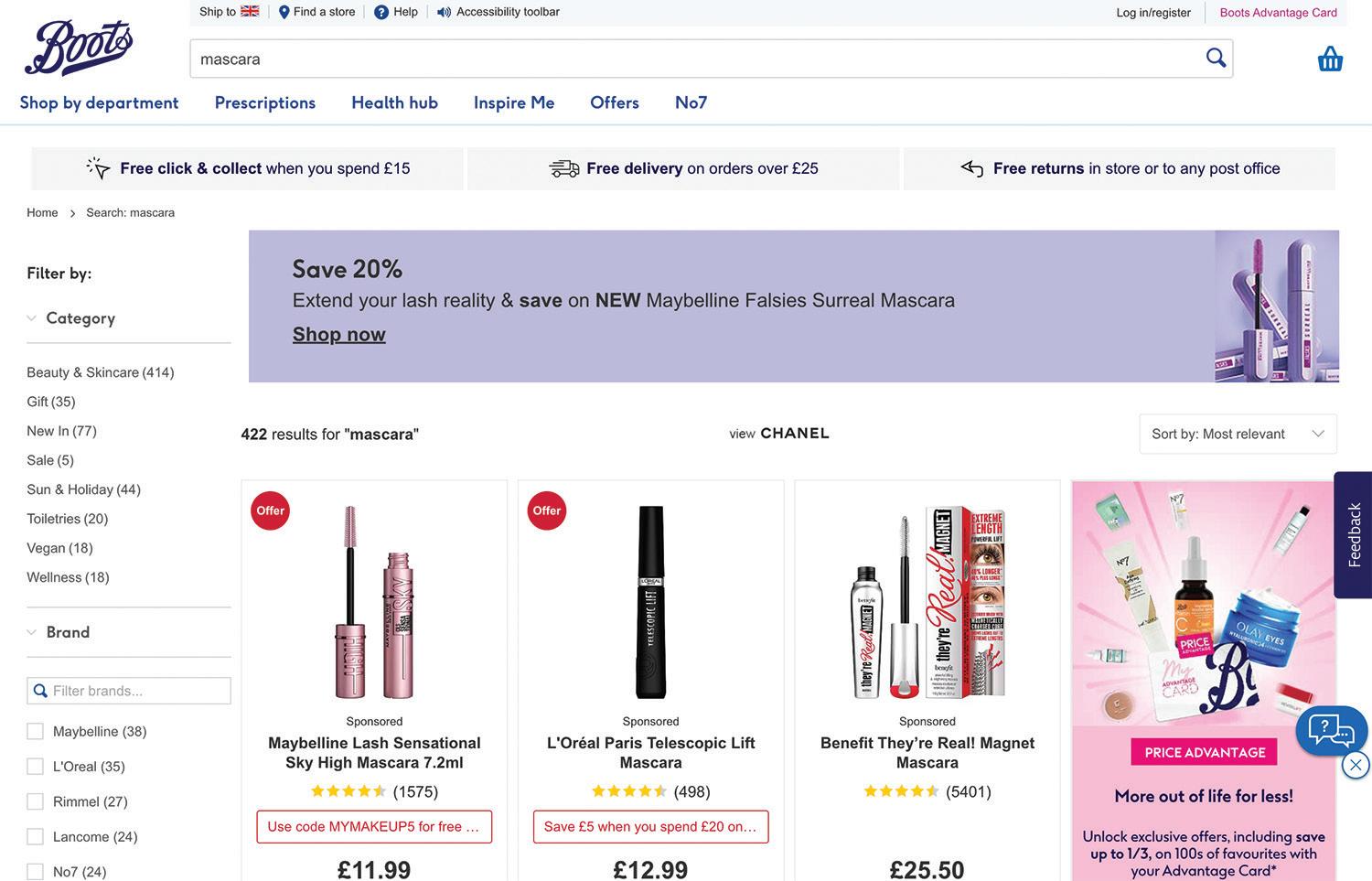

was a bespoke, joint venture: Boots Media Group. “I think the biggest thing for us was not to create an external entity that felt like it was an agency. I think that’s been an incredible piece of work from the guys at Threefold to really integrate into the Boots environment,” says Shayer, adding the team started with 10 employees two years ago and has grown to 40.
Commerce Marketing Across Borders
Want more international coverage on retail media and commerce marketing? Be on the lookout for the September/October issue of P2PI Magazine for an in-depth feature exploring how shopper marketing is evolving across the globe.
And if you are working in commerce marketing abroad and are interested in learning more about our new International Advisory Board, contact Editorial Director Jessie Dowd at jdowd@ensembleiq.com.

P2PI.com
Examining Health & Wellness
A RECENT TRENDS REPORT REVEALS HOW DIFFERENT GENERATIONS FIND GROCERY SHOPPING INSPIRATION.
BY JACQUELINE BARBA
Business journalist Dan Frommer’s new trends report, also titled “The New Consumer,” examines how different generations are fi nding grocery shopping inspiration as well as how consumers are thinking about their health and wellness. Published in collaboration with venture capital fi rm Coefficient Capital, the report leverages the results from a survey of more than 3,000 U.S. consumers as well as exclusive insights from Instacart data — including popular search terms, purchase data, basket affi nities and sales velocity.
Key fi ndings include:
• More than 70% of consumers — across Gen Z, Millennials, Gen X and Boomers — plan to prioritize their health and wellness in the next 12 months.
• Vegetables are the top items consumers want to eat and drink more of this year.
• Many of Instacart’s fastest-growing emerging brands focus on “better-for-you” or environmental values.
• Instacart search interest for “probiotic” items grew 30% last year as online shoppers prioritized gut health.
• 48% of consumers agree that small, emerging brands are looking out for Americans’ health and nutrition.
• 65% of Gen Z consumers believe online grocery stores have a responsibility to recommend healthy food.
• Consumers expect to spend more on groceries this year and less on dining.
Half of TikTok users say they’ve prepared a new recipe because of a video
Which of the following have you done because of a food-related TikTok, YouTube, or Instagram video or post?
a food or beverage recipe
Purchased a food or beverage product from a brand I did not previously know about Purchased a food or beverage product from a brand I already knew about
powered by toluna*
Top 10 Culturally Fluent Brands for Black Consumers
Black Consumer Sentiments
A 2023 study from cultural intelligence and consumer research partner Collage Group examined how Black Americans feel about top culturally fluent brands and companies, and how and where they are engaging most.
In assessing the top brands, Collage Group leveraged its Brand Cultural Fluency Quotient (B-CFQ) score to determine brand resonance across six different cultural factors: fit, relevance, memories, values, trust and advocacy.
Key fi ndings from the study indicate:
• Walmart, YouTube, Lysol, Coca-Cola’s Sprite, Visa, McCormick, Unilever’s Dove, Procter & Gamble’s Febreze, Netfl ix and Google resonate best among Black consumers (out of 320 brands examined).
• 64% percent said they fi nd joy in cooking at home versus eating out, compared to 54% of the total population.
• 63% said they seek new things to do, try and see, including new foods and meals.
• 88% said they follow influencers or content creators on social media platforms, while 42% of the segment follows food and cooking influencers/content creators.
• 72% said they are worried about their fi nances and 83% have called on brands to be involved in social issues in some respect.
• 54% said they are more likely to listen to hip-hop music (including rap), compared to 33% for the total population.
The New Consumer 10 l March/April 2023
Prepared
TikTok YouTube Instagram TikTok YouTube Instagram TikTok YouTube Instagram TikTok YouTube Instagram
TOP BRANDS RANK DIFFERENCE (vs. Non-Black) 1. Walmart 0 2. YouTube +3 3. Lysol +13 4. Sprite +33 5. Visa +1 6. McCormick +43 7. Dove +2 8. Febreze +23 9. Netflix -6 10. Google -2 50% 46% 42% 39% 30% 33% 39% 25% 29% 35% 27% 27% Data: Consumer Trends Survey,
Among
Culturally fluent brands among Black consumers by average B-CFQ score (out of 320 brands) (TikTok n=119, YouTube n=1,452, Instagram n=2,321)
Ate or drank something I otherwise would not have
users of each service. Not all responses shown.
Source: Collage Multicultural
PepsiCo Embraces Shopper Insights
THE MANUFACTURER PARTNERS WITH SYMPHONYAI RETAIL CPG TO BUILD BUSINESS ACROSS MULTIPLE CATEGORIES.
BY CHARLIE MENCHACA
A European division of PepsiCo has successfully leveraged primary shopper data in unique ways.
PepsiCo Northern Europe combined its internal advanced analytics capability with retailer data and solutions from SymphonyAI Retail CPG to bring shopper-led store clustering to more than 1,000 stores. The work resulted in a reset of the salty snacks category in 2022 at a Netherlandsbased multinational grocer, according to a written case study.

“The Netherlands is one of the highest penetration markets for snacks, at nearly 96%, so PepsiCo and our partner can’t really deepen category penetration,” said Jan Haluza, manager of data science and analytics at PepsiCo Northern Europe, in the case study. “Instead, we focus on understanding targeting shoppers very precisely to best align our assortment and category strategy with their needs. We worked with the retailer to undertake a strategic snack category overhaul including consumer insights, space management and supply chain, to drive a major strategic reset.”
PepsiCo Northern Europe and the undisclosed retailer collaborated on an end-to-end, datadriven approach centered on a four-step process:
• Integrate relevant data to create a powerful data set;
• Identify areas of highest growth potential;
• Design a solution with tailored in-store value propositions and personalized shopper engagement to unlock growth; and
• Convert opportunities to growth using continual measurement and improvement.
In this case, the large data set indexed as many as 1,000 characteristics per store. The comprehensive information meant that PepsiCo Northern Europe and the retailer could run advanced analytics models on the data, according to the case study.
After grouping the stores into three shopper-led clusters, PepsiCo had detailed discussions with the retailer about the clusters and solutions for
each. The manufacturer used SymphonyAI for assortment optimization for each cluster while analyzing incremental share of market and assortment models to generate the best scenario for each cluster. Finally, PepsiCo generated planograms for each shelf specifically for different clusters, Haluza said in the case study.
The comprehensive project met multiple goals for the retailer and PepsiCo, said Tessa Maas, senior category manager, food, at PepsiCo Northern Europe.
“The strategic approach [was] tied to overall category vision and how to grow snacks in the future — by brand, flavor, etc., including incorporating shopper decision trees,” Maas said in the study. “We took the time to learn from shoppers how they actually navigate a shelf — do [they] start with a flavor and then fi nd a brand? Or start with the brand and search for a flavor? We developed different priorities, objectives and, in the end, solutions for each cluster.”
The success of the category reset and PepsiCo Northern Europe’s collaboration with Symphony AI and the retailer yielded many benefits. It can serve as a best practice for other PepsiCo markets, Haluza said.
Brand Watch P2PI.com
We focus on understanding targeting shoppers very precisely to best align our assortment and category strategy with their needs.
— Jan Haluza, PepsiCo Northern Europe
Meijer Grocery Debuts
TWO LOCATIONS IN MICHIGAN OFFER A SIMPLIFIED AND CONVENIENT SHOPPING FORMAT AND EXPERIENCE.
BY JACQUELINE BARBA
In 2022, Grand Rapids, Michigan-based mass merchant Meijer announced its first new store format since its neighborhood grocery market debuted in August 2018. The new concept, dubbed Meijer Grocery, launched on Jan. 26, 2023, with the opening of two stores (ranging from 75,000 square feet to 90,000 square feet) in southeastern Michigan’s Orion and Macomb townships.

Meijer says the grocery format is focused on offering a simplified and convenient shopping experience for customers from start to finish. For example, the parking lot at both stores wraps around a singular corner entrance to maximize the number of parking spaces near the door.
Path to Purchase Institute recently visited one of the stores in Macomb Township. Read on to see what stood out to us.
Upon entering the store, shoppers encounter a modern design, featuring tall ceilings, wide aisles and ample lighting and shelf illumination. Each department is clearly identifiable through large, permanent installments hanging above merchandising units and aisles.
The presence of local brands is elevated across the store — most notably in the produce, meat, liquor and bakery departments — with signage communicating messages like “Michigan made” and “Grown close to home.” The store features a larger assortment of produce than other area
stores, as well as a full-service bakery, deli, ready-to-go food counter, meat and seafood counter, and a sizeable BevAlc section.

The store is also more tech-enabled to ease customers’ shopping experience. In the produce department, for example, freestanding scales with digital screens allow shoppers to weigh their produce and print and adhere a label to their item themselves for a quicker checkout.
In the beauty department, an interactive endcap display merchandised Neutrogena products under a digital screen — somewhat similar to ones seen at other Meijer stores. The footage, playing on a loop, invited shoppers to explore the brand’s skincare products showcased below by category (e.g., anti-aging, hydration and makeup remover), while also indicating which shelf they are located on.
In-Store Experience 12 l March/April 2023
Additional elements of the in-store experience that stood out include:
• Smartphone holders affi xed to shopping cart handles — to make referencing a digital grocery list easier, or for scanning product (for those who use Shop & Scan through the Meijer mobile app).



• A self-checkout area for Shop & Scan users or smaller baskets of fi ve items or less.


• An expansive “Pet Shop” department that carries 200 pet toys and more than 500 varieties of treats for dogs and cats from national brands and private labels.

• An eye-catching health and wellness wall stocking protein powders and other related products near the pharmacy.
• Recycling bins near the exit that encourage shoppers to discard plastic bags and other flexible plastic fi lms as part of Meijer’s sustainability efforts. An affi xed sign logs how many pounds of plastic Meijer and its shoppers have recycled together this year. A similar throw-away bin for expired or unwanted medications is positioned near the pharmacy counter.


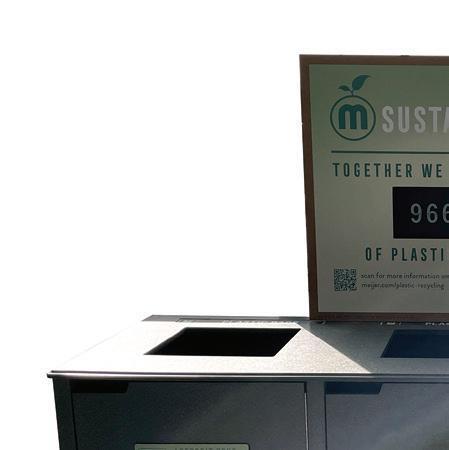
P2PI.com
INTRODUCING OUR 2023 HALL OF FAME HONOREES
BY ERIKA FLYNN
Each year since 1994, the editors of the Path to Purchase Institute have selected three industry leaders for induction into the Hall of Fame. From their daily business practices to the work they produce, these honorees represent the very best of the commerce marketing industry. Collectively, these professionals have proven that they don’t just follow the path to purchase; rather, they help build it. The 2023 inductees are:
• Mimi Dixon, Crayola

• Brent Rosso, Ulta Beauty (page 18)
• Bob Waibel, Conagra Brands (page 20)
For a complete list of Hall of Fame inductees, visit P2PI.com/HallofFame.

14 l March/April 2023
Mimi Dixon
Director,

Brand Activation and Content Crayola
Mimi Dixon thrives on connecting with consumers. That started when she worked at Barnie’s Coffee & Tea Co. in high school. It was there she got her first taste of marketing, sales and consumer interactions. And even though her first years of college took her down a different path, she never lost that passion.

Today, as director of brand activation and content at Crayola, Dixon leads a team that creates consumer connections every day, guided by four overarching principles: authenticity, transparency, credibility and inclusivity.
THE EARLY YEARS
Dixon was the oldest of four children, raised in a single-parent household in Camden, New Jersey. She came from meager beginnings and was the fi rst in her family to attend college. One of her earliest lessons was the value of always striving to be better and not being afraid to branch out.
Her early years included experiences through CHAMP (Creating Higher Aspirations & Motivations Project), a summer program out of nearby Rowan University that took inner city kids camping, taught them science, math and sociology so they could learn to network and connect, and eventually introduced them to college. This program helped her on her college endeavors, and she later gave back as a camp counselor.
Dixon also took advantage of a state-certified emergency medical technician program in high school. She was an EMT for a few years, and says it opened her eyes to the world around her. It also dimensionalized the deep roots of prejudice when she encountered racism on the job.
CAREER DEVELOPMENT
After graduating, Dixon moved back to Camden and landed as a temp at Campbell Soup Co. “I had been around Campbell’s headquarters all my life, but never thought about working there,” she says. She proved quickly that she was more than ready
for a permanent position after working on one of its signature education programs, Labels for Education, and they created a role for her.
Throughout high school, Dixon also participated in a summer program minored in political science, which led her to a masters
Throughout high school, Dixon also participated in a summer program called PRIME (Philadelphia Regional Introduction for Minorities to Engineering) and was encouraged to follow the engineering path in college. After two years, she pivoted and went on to earn a degree in sociology from Rutgers University, following her passion for understanding people and connections. She minored in political science, which led her to a masters of public administration from the University of Delaware, during which she was a legislative fellow with the Delaware House of Representatives.
P2PI.com
MIMI DIXON
Title: Director, Brand Activation and Content


Company: Crayola
Team Members: Stephanie Hudson, brand content manager; Erika Merklinger, public relations and communications manager; Pam Garrity, marketing coordinator.
Career Path:

• Crayola, director, brand activation and content (2017-present), customer development and national activation - sales (2014-2017)
• Campbell Soup Co., senior group manager, shopper marketing – Campbell North America (2013-2014); senior group manager, integrated consumer and shopper marketing (2010-2013), senior group manager/senior manager - consumer marketing (2003-2009), promotions associate/assistant manager/ manager - consumer marketing (1998-2003)
Industry Activities:
• Keynote speaker: 2021 ANA (The Association of National Advertisers) Multicultural Marketing & Diversity Conference & Awards; Disney Marketing Townhall; Dolby360 Marketing Townhall; John Deere Inclusion Summit; Kellogg’s Innovation Townhall; Pearson Inclusion Summit; Pernod Ricard Marketing Townhall; Inspira-Enthuse Marketing; NPR Marketing Townhall;
• Panelist speaker: Red Bull; SHRM (Society for Human Resource Management) Inclusion Summit; NEW (Network of Executive Women) Summit
• Judge: ANA Multicultural Awards, Effie Awards, Reggie Awards, AME Awards
Education: Rutgers University, Bachelor’s, Sociology/Political Science; University of Delaware, Master’s, Public Administration, State and Local Management.
She started as a promotions associate, and during her 16-year tenure took roles of increasing responsibility, ultimately holding the position of senior group manager – shopper marketing, Campbell North America. It was a lesson in transferable skills entering the world of CPG. “A lot of what I learned working on my master’s transferred over to Campbell Soup, almost like an MBA but for the public,” she says. “Being able to put products together, fulfilling a need for the consumer and witnessing the ambassadorship. I liked that, and I wanted more of it.”
Through her Campbell Soup years, she worked in consumer promotions and then moved into shopper marketing, working on different brands in each of her roles. She led the Chunky Soup Mama’s Boys Campaign in partnership with the National Football League for eight years, and eventually led Labels for Education as well, which was her first experience with a cause-focused program.

She counts both as some of her best work while with the company, along with what then became the label’s largest causal program with the U.S. Postal Service, Stamp Out Hunger, in collaboration with Feeding America. Giving back and helping others in need will always ring true for Dixon. “To be able to have a program that was simple and effective, but where we could really make a difference — that’s a message right after my own heart.”
Dixon says Campbell Soup’s then-CEO Doug Conant made a significant impact on her early career. He brought diversity, equity and inclusion (DEI) efforts and employee resources groups to the company, advocated for healthy lifestyles and was the biggest proponent of work/life balance — all while staying connected to employees on a regular basis and making them feel valued.
Terry Atkins, Dixon’s fi rst director of integrated marketing; Anne Pizzaro, her fi rst manager; and Angel Sasso, who created the position for Dixon when she was hired on, all played integral roles in her growth and success at the company.
l March/April 2023
Everything we did went through this lens of those four guiding principles [authenticity, transparency, credibility and inclusivity]. Even to this day, when we’re looking at partners for Colors of the World, we look through that lens. If they stand up to those guidelines, that’s what moves us forward.
MAKING HER MARK AT CRAYOLA
In 2014, Dixon decided it was time to branch out again and made a move to Crayola. She seized the opportunity to lead shopper marketing under Nancy DeBellis, director of customer leadership.
Crayola offered an entrepreneurial spirit and an organizational structure in which she was involved in more planning, discussions, pitching to senior leaders and aligning with them. “It was a whole new level of marketing, presentation skills and political savvy,” she says, adding that her involvement with retail partners increased, which was an exciting change for her.

Eventually she began overseeing the company’s merchandising efforts and, in 2017, she assumed her current position of director, brand activation and content.
Dixon has watched the practice of shopper marketing evolve. Retailers are still looking for ways to engage shoppers, she notes, but are looking to add more value. “Together we want to give more to shoppers,” she says. “We have to ask ourselves how we can do that, whether with content, exclusive product or something else. Here are the bare bones of the product, but how do we give them more?”
An added focus is on leveraging microseasons, on top of the seasons the company has historically activated against. “So think Halloween, Earth Day or Valentine’s Day,” she says. “Other moments that matter, if you will, outside of the big tent poles, when we can engage consumers and give them value add.”
Engaging with teachers and being a better resource for them, as well as new ways to drive loyalty, are also points of discussions right now at Crayola. And finally, supporting DEI. “Retailers want to partner to be more inclusive and make sure we’re not missing any key groups of consumers in our work,” she says.
When the company partnered with beauty industry expert Victor Casale for a new product launch, Dixon led the charge. Colors of the World introduced 24 newly developed colors, which represent 98% of the global population, and became the most successful launch in Crayola history.
Dixon encourages teams to learn from other industries, and to break the mold when given the opportunity. “Don’t be afraid to do things differently,” she says. Crayola had to learn how to produce paint around the Colors of the
World line, something it had never done before. She says the company culture must support the work/product and live into four key principles of authenticity, transparency, credibility and inclusivity.
“Everything we did — from R&D to reaching out to consumers, understanding packaging, crayon labeling, marketing, PR — went through this lens of those four guiding principles,” she says. “Even to this day, when we’re looking at partners for Colors of the World, we look through that lens. If they stand up to those guidelines, that’s what moves us forward.”
INTO THE FUTURE
Furthering DEI will continue to be a goal for Crayola, says Dixon, as they look at product portfolios and even marketing and content to go after those populations. She and her team are also looking at generational relevance and interconnectivity. “We have products for everyone, and we have to keep those generational congruencies in mind,” she notes. “We have our key target area of elementary school, but how do we make sure we are aging up and growing with you after that?”
Finally, there is work around furthering engagement with its brand mission — communicating to consumers that Crayola has a broader mission in addition to the products it sells.
P2PI.com
Brent Rosso Vice President of UB Media Ulta Beauty
Brent Rosso has never been one to shy away from a good startup challenge. A native of the Twin Cities in Minnesota and classically trained as a marketer, he never could have predicted his career path coming out of college. He says job prospects have come and gone that would have taken him away from his hometown, but instead he chose to stay right where he’s always been. And now, with four startups under his belt, he says being in the right place at the right time, recognizing challenges as exciting opportunities — and a stroke of luck here and there — have made for a rewarding and fun ride.
THE EARLY YEARS
Rosso, who values his childhood growing up with his parents and brother, remembers the lasting impact a sixth-grade teacher had on building his confidence. “At one point, I said I wanted to be a lawyer,” he recalls. “Her response was, ‘You got it, kiddo.’” The power of her support stayed with him, from his first jobs as a kindergarten soccer coach and lifeguard at the city municipal pool, to his current post as vice president of UB Media at Ulta Beauty.
A graduate of the University of St. Thomas with a degree in marketing, Rosso says it was his economics studies (for which he earned a minor) that landed him his first position as an e-commerce manager for online advertising at Fingerhut.
CAREER DEVELOPMENT
Fingerhut was the second-largest catalog company in the nation at the time, and Rosso learned the true disciplines of database and direct marketing. “I was a sponge,” he says. But the job lacked the innovation that he began to realize would fuel his drive going forward.
“They had been around for 100 years and it was a finely tuned machine,” he recalls. Soon after, he was “plucked up” with three others and put in a corner of the organization. “We were told there was this internet thing … go figure it out,” he says. “We did some really cool stuff after that and had a ton of fun building out our digital strategies.” That four-person digital team eventually grew to more than 200 in about 18 months.
Federated Department Stores eventually bought Fingerhut, but Rosso says it wasn’t the best marriage. The day after Fingerhut shuttered, he was in on the ground floor of a new operation: a small mom-and-pop lighting showroom that needed to build its catalog business. As the marketing director of Bellacor, Rosso helped build it from scratch to a category leader within two years.
In 2005, he moved a couple of miles down the road to work in e-commerce for the retail giant that had always been in his backyard. His work at Target would be similar: to build its media presence, starting as the manager of online advertising.
Rosso would go on to spend more than 14 years at Target, ultimately holding the post of vice president of digital media. He led all digital media channels and built teams internally and/or partnered with one of its many agencies to run those businesses, while also standing up new product teams.
“We were building capabilities, based on our data and technology, to support those channels,” he says. “That was very successful — to the point where the marketing organization asked to expand beyond just media and think more holistically for marketing.” A number of product teams stood up to support the marketing organization in that agile manner, he notes, “and that was really cool because what an unlock that became in how we operated and got stuff done.”
He also led the measurement team, which he believes truly transformed the marketing organization, considering how little measurement there was at the time. “We were meeting with the CMO and CFO and their direct reports monthly, reviewing measurement

18 l March/April 2023
and making real-time changes not just in digital, but even in our broadcast media,” he says. He also led an audience strategy team, and a programmatic strategy and activation team in Bangalore, India.
By 2010-2011, Rosso says Target executives realized this martech foundation was the basis for a new business at the retailer. More specifically, a retailer media network and a more modern approach — and Rosso was tapped to help write the business case for launching that division. “This was all about leveraging that first-party data and understanding the outcomes associated with doing that wherever you might reach customers,” he says. He then guided the launch, leading everything but the sales organization for what is now Roundel at Target.
Rosso says he’s had many great mentors over the years, but Ron Neher, who headed up e-commerce development during Rosso’s early days at Fingerhut, taught him about leading people and teams. That’s what Rosso is most proud of today: the teams he has been a part of throughout this journey. “It’s not about me at all, but about building a team,” he says. “When you come together and empower them to do and see where we want to go, they take you there.”

Rosso spent the next three years consulting for both retail media networks as well as the martech/adtech space.
IMPACT AT ULTA
When the opportunity to lead the retailer media network for Ulta Beauty (dubbed UB Media) arose, Rosso just couldn’t pass it up. It was a strategic initiative for the organization, and 95% of all transactions are tied to Ulta’s loyalty program. Working in a corporate culture that he describes as a “breath of fresh air,” he in October 2021 built another team that is tasked with reimagining and building more capabilities within UB Media’s foundation — and equipping it to handle much more scale. “That team will make or break us, so that’s where we’re spending the majority of our time right now,” he says.
RETAIL MEDIA GOING FORWARD
Rosso sees retail media’s growth as both exciting and rewarding — and views change as opportunity. He encourages his team members to embrace the ever-rapid changes in the space and to think about what might be next. Their guiding principle is to always do best by the guest. “This retail media network is not a business that sits on the side of Ulta Beauty — we are core to everything that we do.”
Rosso stresses the importance of collaboration with brand partners and especially clients to build stronger relationships. He says his team will continue to focus on building out more owned and operated inventory via the web and their app, but also in physical stores. “That’s a white space in the retail media network space,” he says, “And we believe there’s tons of opportunity there.”
As retail media networks continue to pop up and consolidation is not as likely across retailers, it’s the networks’ job to determine what that means for the retail media network space, Rosso says. “We have to figure out ways to come together and make things easier for our clients and our brand partners. That’s a challenge we’ll have to think more and more about.”
BRENT ROSSO
Title: Vice President of UB Media
Company: Ulta Beauty
Team Members: Dom Manna, director of advertising operations for UB Media; Alyson Soderberg, senior director of sales and account management for UB Media.
Career Path:
• Ulta, Vice President, UB Media (2021-present)
• Independent Consultant and Advisor (20192022)


• Target, Vice President of Digital Media (20142019), Director, Digital Media (2012-14), Senior Group Manager, Digital Media (2010-2012), Group Manager, Digital Media (2009-2010), Senior Manager, Online Media (2007-2009), Manager, Online Advertising (2005-2007)
• Bellacor, Marketing Director (2002-2005)
• Fingerhut, E-Commerce Manager, Online Advertising (1997-2002)
Industry Activities:
• Lecturer, Kellogg School of Business Northwestern University and Carlson School of Marketing University of Minnesota
• Speaker, Cannes Lions, AdWeek, Mobile Marketing Association, MediaPost, Beet.TV, LiveRamp
• Former member of: Google Retail Advisory Council, AOL Retail Advisory Council, DoubleClick Client Advisory Council, MSN Client Advisory Board, Association for Interactive Marketing: Council for Responsible Email
• Active member of: IAB Retail Media Network Committee
• Industry accolades: Best Digital Marketer, Internet Retailer; People-Based Marketing Pioneer, Digiday; Best Use of Programmatic Technology, AdExchanger; Mobile Marketer of the Year, MMA; and Media Company of the Year, MMA.
Education: University of St. Thomas, Bachelor’s, Marketing and Economics.
P2PI.com
Bob Waibel Senior Director, Commerce Marketing Conagra Brands
Bob Waibel grew up thinking he’d be a salesman. His father spent more than 30 years in sales at IBM, and although the younger Waibel wasn’t sure of his path, he was confident (in high school, anyway) that being a salesman was his end goal as well. But a marketing degree from the University of Missouri and a well-known brewery in his hometown changed all of that for him.
This year marks Waibel’s 45th year in the industry, having spent time on both the CPG and agency sides of the business. He is the senior director of commerce marketing at Conagra Brands, leading a team of 20 whom he says “day in and day out deliver great commerce marketing activations for our customers and our brands.”
THE EARLY YEARS
Waibel grew up in St. Louis in a family with four brothers and sisters. He spent weekends sailing with his dad at Carlyle Lake in central Illinois and bagging groceries at Schnucks early in his high school days. He worked there all through college when he was home, eventually becoming a part of the grocery team and stocking shelves.
His first job out of college was as a manager of promotions at Anheuser-Busch. He had come back to St. Louis, networked and found himself traveling to wholesalers weekly, doing everything from sales, merchandising and store resets to equipment audits, counting barrels in the marketplace and special events. He spent eight years with the company in total, ultimately working in consumer promotions.

20 l March/April 2023
CAREER DEVELOPMENT
Waibel’s next stop was at marketing agency The Waylon Co. At the time, agencies were springing up in St. Louis because of Anheuser-Busch (A-B) and other large CPGs. “I’d been working with agencies from the client side and this gave me an opportunity to understand how an agency operated from the inside — what the creative process to final art looked like, how an agency makes money, etc.,” he says.
Then came his chance to work at another world-class company. Waibel had lived in Atlanta while at A-B, and both the area and a job opportunity with The Coca-Cola Co. were too good to pass up. He began in the Fountain Division (now Foodservice), working with major on-premise customers that served Coca-Cola fountain drinks.
“We functioned very much like an internal agency resource to our Fountain customers, developing promotions that would drive Coca-Cola’s and our customers’ businesses,” he says. It was there he learned what great customer marketing looked like and how to make it work — for consumers, customers and its brands. He then moved into a channel marketing manager role, working on strategic planning for the casual dining channel for the Fountain division.
Waibel was at Coke for more than seven years before he moved back to the agency side, working on the bottler’s business. “The work was similar to what I was already doing inside Coke, but it was an opportunity to have a greater role in leading teams and managing the growth for a company which, on the agency side, means new business development,” he says. He held VP positions at Draftfcb, Ogilvy & Mather (BEN Marketing) and Arc Worldwide (Leo Burnett) for more than six years.
With invaluable agency-side experience under his belt, Waibel joined ConAgra Foods in 2007, realizing his passion for working for one company and that company’s goals. He moved to Tampa, Florida, to handle the east region shopper marketing efforts and, eight years later, landed in Chicago to

take over all of shopper marketing as senior director.
Waibel’s early work at Anheuser-Busch were some of his first big wins. “Competitive breweries were spending big dollars to sponsor The Rolling Stones, The Who, etc.,” he says. “We wanted to find a more economical way to do something that not only created visibility for our brands, but that our wholesalers could leverage more effectively in local markets broadly.”
His group teamed with its agency The Comedy Store in Los Angeles to identify a group of up-and-coming comedians to take out on tour, eventually securing Billy Crystal and others. “The program was less expensive than trying to sponsor a major rock group tour,” he says. “We were able to execute it in far more markets and our wholesalers could use it to drive displays and promotions in their markets.”
Waibel points to mentors who have guided him throughout his career, including Bill Schmidt, at both Anheuser-Busch and on the agency side, who helped teach him how to navigate the corporate world early on. He says a boss at Coca-Cola, Chandra Stephens-Albright, gave him sound guidance that he’s passed on many times since: “Don’t just go looking for jobs; identify what you enjoy doing first. You’ll find more enjoyment that way.” And longtime colleague Mike Buczkowski, CEO of Digitix, continues to be someone he looks to for advice and coaching.
IMPACT AT CONAGRA
When Waibel landed at ConAgra Foods (which became Conagra Brands in 2016), then-SVP of marketing Mike McMahon (a P2PI Hall of Famer himself) was just beginning to build out the shopper marketing discipline. For him, it was an opportunity to work with experienced marketers Tammy Brumfield and Tom Lisi, and build out the function. “We put together a shopper marketing team that was really at the forefront of how to structure a shopper marketing function,” he says. “We established a team structure, processes and ways of working that did not exist previously. And they were truly industry-leading.”
P2PI.com
The Conagra Brands Commerce Marketing team, from left: Shannon Staunton, Joyce Goolsby, Keisha Edgar, Andrea Knight, Lisa Matos, Stephanie Reiman, Jen Martin, Jeff Muench, Alyson Welch, Olivia Brink, Bob Waibel, Kristen Klei, Matt Pabst, Gene Karaffa, Tim Schatz and Reshma Schneider.
About two years ago, the team evolved from shopper marketing to commerce marketing, which was much more than just a name change, Waibel notes. “We have made it our team’s focus to ‘make every moment shoppable,’” he says. The evolution is driven by several macro trends, including a dynamic store experience, with automation/AI and external forces such as the pandemic changing how consumers shop in-store; omnichannel evolution in which physical and digital commerce have combined; and new customer platforms, such as the strong emergence of retailer media networks.
“My team has expanded our focus to continue to fi nd ways to drive our brand relevance with shoppers in every area they’re shopping — instore and online,” he says.
BOB WAIBEL
Title: Senior Director, Commerce Marketing
Company: Conagra Brands


Team Members: Matt Pabst, Director of Commerce Marketing; Tim Schatz, Director of Commerce Marketing; Reshma Schneider, Director of Commerce Marketing.
Career Path:
• Conagra Brands, Senior Director, Commerce Marketing (2016-present); Senior Director, Shopper Marketing (2007-2016)
• Arc Worldwide, Vice President, Account Director (2004-2007)
• Ogilvy & Mather (BEN Marketing) Vice President, Client Services (2002-2004)
• Draftfcb, Vice President, Group Account Director (2001-2002)
As retailer media networks continue to pop up and retailer-specific shopper data becomes more available, Waibel says his team looks to drive Conagra Brands’ sales across the whole retailer ecosystem through marketing activation by leveraging shopper and retailer expertise, which includes shopper data with its customers.

“How and where my team focuses its efforts has become much broader,” he notes. “Not only are we fi nding ways to disrupt shopper journeys in-store with incremental displays and in-store activation and communication, but we’re also making sure our brands are showing up and standing out on the retailers’ digital shelves.”
LOOKING AHEAD
Measurement will continue to be a big focus for Waibel and his team. Pinpointing accurate, reliable and meaningful measurement and ROIs that are attributable specifically to shopper marketing initiatives has always been the challenge. “Add in retailer media networks, and it gets really complicated,” he says.
While ROAS (return on ad spend) has become the default metric, he’s not convinced it’s the right metric for success in the omnichannel space. It’s a constant battle, but one his team will continue to fight with all of its partners. “We also have to get to some standardization [between the different methodologies and metrics] so we’re looking at things the same way across the universe,” he says.
• The Coca-Cola Co., Trade Channel Marketing Manager (1997-2000); Senior Program Development Manager (1996-97); Promotions Manager, National Accounts (1993-1996)
• Fruit of the Loom, Sales Promotion Manager (1992-1993)
• The Waylon Co., Account Supervisor (19891992), Senior Account Executive (1987-89)
• The Seven-Up Co., Manager, Promotion Programs (1986-1987)
• Anheuser-Busch (1978-1986)
Industry Activities:
• Guest lecturer at University of Chicago, Indiana University and University of Florida
• Multiple Path to Purchase Institute committees, most recently as part of the Commission to Standardize the Measurement of Shopper Marketing
• Final Round Judge for the Commerce & Shopper Effie Awards
Education: University of Missouri, Bachelor’s, Marketing.
22 l March/April 2023
How and where my team focuses its efforts has become much broader. Not only are we finding ways to disrupt shopper journeys in-store … but we’re also making sure our brands are showing up and standing out on the retailers’ digital shelves.
Sneak Peek




HERE’S THE INSIDE SCOOP ON WHAT TO EXPECT AT FUTURE FORWARD, MAY 16-18 IN NEW ORLEANS.

Keynote Speakers
Tuesday, May 16:
• Trend forecaster Sean Monahan, the founder of 8Ball, will explain why culture is more incomprehensible than ever before, and what brands can do to cut through the hype. His general session is titled “After the Vibe Shift: What’s Next for Consumers and Society.” The keynote/ main stage sponsor is 84.51.

Wednesday, May 17:


• In this general session with Ari Peralta, neuroscientist and sensory designer at Arigami, discover the evolution of sensory design and prepare for the future of commerce with the latest research insights and applied case studies. The keynote/main stage sponsor is 84.51.


Additional sessions in the conference lineup will explore:
• Retail media metrics; shopper engagement; online vs. offl ine shopping; measurement; the in-store shopping experience; and Web3.
A New Orleans Experience
Beginning at approximately 10 a.m. on Thursday, May 18 (dependent on which experience you select at registration), attendees will go on a New Orleans adventure of their choosing. (Visit P2PIFutureForward.com for more info).

• Glamorous Garden District Tour with Cemetery
• The Local’s Guide to the French Quarter Tour
• Sinister Criminal Intentions: the Original True Crime Tour
• New Orleans Bus Tour
• Breakfast at Brennan’s
Futures & Legends Roundtable and Lunch
Awards Ceremony & Cocktail Reception
From 5 p.m.-7 p.m. on Wednesday, May 17, the Path to Purchase Institute will honor the next generation of leaders (the 2023 recipients of the 40 Under 40 Awards) as well as three industry icons (the 2023 Path to Purchase Institute Hall of Fame inductees) during an awards ceremony and cocktail reception. Come network with your fellow Future Forward attendees while celebrating this year’s winners.



At noon on Tuesday, May 16, join us for this roundtable and lunch — where you’ll be seated with the Path to Purchase Institute’s prestigious Hall of Fame honorees, members of the Commerce Executive Network (CEN) and the winners of our 40 Under 40 Awards. We will explore a variety of topics at the tops of marketers’ minds during this interactive session.
EVENT REGISTRATION





For more information, including the complete agenda, and to register, scan this code.

Examining the Experience In-Store Shopping
BY JENNY REBHOLZ
Whether expected or unexpected, change is inevitable. In recent years, the highs and lows of global changes have taken consumers, brands and retailers on a roller coaster ride. From the upending experience of the COVID-19 pandemic to the pain points of inflation and the uncertain economic predictions ahead, news of consistency can provide a little comfort and relief.
When it comes to the evolution of the in-store shopping experience, consistency is exactly what our latest survey has revealed. The over 1,000 respondents from the Path to Purchase Institute’s January 2023 consumer survey are reporting similar behaviors and frustrations compared to 2022.
This data reiterates important areas for brands and retailers to focus on and again shows opportunities to garner shopper attention, gain customer loyalty and elevate the in-store experience. The 2023 report offers insights into consistent shopping patterns, new areas of opportunity, and the trends and topics on consumers’ minds that could influence future behaviors.
Shopping Behaviors
Consumer habits continue to be affected by global issues. COVID-19 and other health factors, inflation and economic struggles, war and
political upheavals, supply chain struggles and worker shortages impact shoppers in different ways. In the survey, respondents referenced inflation and shopping on fixed incomes and within tight budgets, but their responses demonstrate some consistencies in their overall shopping behaviors.

Similar to last year’s report, over half of the respondents continue to shop at least once a month in the categories of grocery, pet care, non-food household essentials, personal care items, cannabis, alcoholic beverage and medication. While 97% shop for groceries once a month or more, respondents noted shopping less than once a month for electronics, office supplies, home décor, home improvement, sporting goods and apparel.
For those who shop at least once a month per category, grocery, cannabis, sporting goods and electronics top the list for shopping frequency. The grocery and pet care categories continue to rank highest among consumers who shop less often than once a month. No matter the frequency, in-store trips
24 l March/April 2023
SPECIAL REPORT
Our latest research provides updated insights into shopping patterns, new areas of opportunity and the factors that could influence future behaviors.
In collaboration with
Shopping Frequency by Category
Typically shopped for once a month or more often
Typically shopped for less often than once per month
Q. How often do you typically shop for each of the following (including all shopping visits in a physical store and online)?
Number of Times Shopping Category per Month
Percent of Shopping Done In-Store
Q. In a typical month, about how many times do you shop for each of the following (including all shopping visits in a physical store and online)?
Q. And in a typical month, about how many times do you go to a physical store to shop for each of the following?
P2PI.com
Path to Purchase Institute Evolution of the In-Store Shopping Experience Study (January 2023)
Grocery (food & beverage) Pet care (food & supplies) Non-food household essentials Personal care items Cannabis Alcoholic beverages Medication Apparel Sporting goods Home improvement Home decor Office supplies Electronics 97% 3% 74% 26% 72% 28% 71% 29% 62% 38% 60% 40% 59% 41% 32% 68% 32% 68% 28% 72% 23% 77% 20% 80% 18% 82% At least once a month or more often Less often than once per month
Path to Purchase Institute Evolution of the In-Store Shopping Experience Study (January 2023)
(Among those who shop once per month or more often)
Grocery (food & beverage) Pet care (food & supplies) Non-food household essentials Personal care items Cannabis Alcoholic beverages Medication Apparel Sporting goods Home improvement Home decor Office supplies Electronics 6.74 4.76 3.40 3.21 4.76 4.00 3.44 3.71 4.00 3.99 3.82 2.98 4.00 3.10 2.72 2.54 3.86 3.09 2.53 2.36 2.40 3.14 3.18 2.13 3.04 2.38 All shopping In-store shopping
Grocery Pet care Non-food household essentials Personal care items Cannabis Alcoholic beverages Medication Apparel Sporting goods Home improvement Home decor Office supplies Electronics 71% 80% 79% 77% 81% 77% 74% 64% 60% 79% 83% 71% 76%
account for at least two-thirds of shopping across categories.
Cannabis, alcoholic beverages, personal care items, pet care and non-food household essentials are the overall categories most likely to be shopped for in-store. This reinforces that brands and retailers continue to have opportunities to connect with consumers and build loyalty in-store.
Changes in Shopping Habits
As society has recalibrated into a post-pandemic normal, in-store shopping has been more than an opportunity to get out of the house. Not only are shoppers still heading to physical retail, but they are also shopping in-store more often. Compared to a year ago, shoppers frequenting grocery stores increased 22%, while those visiting mass retailers rose 14%. While fewer in-store trips are noted for office supplies, sporting goods/outdoor activities, electronics and home improvement, the data across the majority of categories demonstrates a frequency increase from 2022.
When it comes to the duration of stock-up shopping trips, 50% of respondents said they are spending a similar amount of
time in the store. However, one in five shoppers noted spending more time in-store. This is a 6-point increase compared to last year’s study.
Of particular interest are the changes in shopping habits reflected in responses from younger, Gen Z and Millennial shoppers. They indicated shopping in physical stores more often compared to a year ago, and spending more time while they are there.
In terms of the number of items purchased in a given shopping trip, again approximately 50% of those surveyed said they are purchasing the same amount, while one-third reported purchasing more items during a single stock-up trip. This percentage reflects a 12-point drop from last year. In correlation with the increase in in-store shopping trip frequency, this suggests consumers may be regaining a sense of comfort in physical retail post-pandemic.
In-Store Shopping
While digital content consumption and daily screen time stats
Number of Times Shopping Category in Three-Month Period
(Among those who shop less often than once per month)
Percent of Shopping Done In-Store
Q. You said you shop for the following less often than once per month. In a typical three-month period, about how many times do you shop for the following (including all visits in a physical store and online)?
Q. And in a typical three-month period, about how many times do you go to a physical store to shop for the following?
26 l March/April 2023
*Small base size Path to Purchase Institute Evolution of the In-Store Shopping Experience Study (January 2023)
Grocery* (food & beverage) Pet care (food & supplies) Non-food household essentials Personal care items Cannabis Alcoholic beverages Medication Apparel Sporting goods Home improvement Home decor Office supplies Electronics 5.02 3.18 3.15 1.96 1.52 1.56 1.48 1.66 1.41 1.76 1.41 1.56 1.52 1.58 1.93 1.33 1.17 1.25 1.10 1.16 1.01 1.09 1.01 1.14 1.00 1.29 All
shopping In-store shopping
Grocery* Pet care Non-food household essentials Personal care items Cannabis Alcoholic beverages Medication Apparel Sporting goods Home improvement Home decor Office supplies Electronics 63% 61% 68% 82% 77% 80% 74% 70% 72% 62% 72% 73% 66% SPECIAL REPORT
continue to increase, our survey confirms that shoppers still have the desire to see and interact with products in person — 65% of respondents prefer in-store shopping for hands-on engagement with the merchandise. This ranked as a primary reason for respondents (no matter age or ethnicity). In addition to the 42% who like to avoid shipping costs, 40% of shoppers enjoy the immediate gratification of in-store purchases. These primary drivers of in-store shopping are consistent
with the 2022 report. This presents opportunities for brands and retailers to create engaging hands-on experiences with products and leverage these interactions.
When it comes to younger shoppers, they are motivated to shop in-store by factors such as wider selection, ease of returns, inspiration, the social aspect of going in-store, product samples and expertise/assistance from store associates (which were ranked higher by Gen Z and Millennials
of Shopping at Store Type
Q. Compared to a year ago, how often do you go inside the following types of physical stores?
Time Spent In-Store During Stock-Up Trip
Q. Think about going into the types of stores where you tend to pick up multiple items. On a typical shopping trip when you go into a physical store to pick up multiple items, about how much time do you spend in the store now, compared to a year ago?
P2PI.com
Frequency
Path to Purchase Institute Evolution of the In-Store Shopping Experience Study (January 2023)
Grocery/supermarket/discount/specialty Supercenter/mass merchandise Dollar store Convenience store Clothing retailer Wholesale club Craft store Health & beauty Home improvement store Drugstore Pet store Electronics store Sporting goods/outdoor activities store Office supply store 3% 9% 57% 31% 4% 28% 54% 14% 11% 23% 48% 18% 20% 21% 42% 17% 16% 26% 41% 17% 28% 15% 40% 17% 30% 18% 35% 17% 26% 18% 40% 16% 14% 24% 47% 15% 12% 19% 55% 14% 41% 12% 35% 12% 21% 23% 44% 12% 34% 26% 22% 29% 33% 37% 11% 8% Not at all Less often More often About the same
Path to Purchase Institute Evolution of the In-Store Shopping Experience Study (January 2023)
> 30 fewer minutes than I used to 1-15 minutes longer than I used to 1-15 fewer minutes than I used to > 30 minutes longer than I used to 16-30 fewer minutes than I used to 16-30 minutes longer than I used to It’s about the same 9% 6% 8% 5% 11% 11% 50% Fewer: 28% (-12 pts from 2022) Longer: 22% (+6 pts from 2022)
SPECIAL REPORT
compared to their Gen X and Baby Boomer counterparts). Elevating these aspects of the instore experience may help deepen connections with this maturing customer base.

In-store technology is another area that brands and retailers can leverage to further engage with younger shoppers. The ability to tap-to-pay at checkout (39%), create a shopping list app on a mobile device (33%) or use a mobile app to track spending as items are added to a cart (32%) were topics of interest to respondents, with younger shoppers showing significantly more interest in these technology features.
Other aspects of the in-store experience, such as store cleanliness, ease of checkout and consistently having items in stock continue to maintain relevance from a year ago. These factors rank highest for influencing shopper satisfaction with the in-store experience. Interestingly, experiential offerings, eye-catching visuals/ displays and the overall store ambience are seen as less important.

When looking for category-specific opportunities to improve the in-store experience, consider that immediacy of purchase is particularly important for grocery, medication and apparel. Brands and retailers in the cannabis and home decor categories should note that respondents rank discovering new products, enjoying the treasure hunt experience and the social aspect of going in-store as more important.
The primary in-store shopping pain points have also remained the same since the 2022 survey. Products out of stock, the ability to find what they are looking for and the checkout experience continue to be areas of frustration. Also of note, approximately one-third of shoppers said wayfinding is a challenge.
As companies continue to face labor shortages that impact some of the customer service-related pain points, brands and retailers remain tasked with addressing efficiency and service to elevate the in-store experience.

Spontaneous Purchases
According to the survey responses, brands and retailers have opportunities to entice shoppers to make spontaneous in-store purchases. Nearly half of survey respondents said they often make spontaneous purchases in-store compared to one-quarter who do so when online shopping. Price and promotions play a key role in grabbing shopper attention, with 57% being influenced to
Quantity Purchased During a Stock-Up Trip
Less: 13% (+3 pts from 2022) More: 36% (-12 pts from 2022)
51% 19% 17%
It’s 3% 10%
I buy a lot less than I used to in one store visit about the same I buy a little more than I used to in one store visit
I buy a little less than I used to in one store visit I buy a lot more products in one store visit than I used to
Reasons for Shopping In-Store

Wider range of selection Easier to navigate/find products in-store (compared to online)
Ease of making returns
Inspiration/discovering new products
The social aspect of going in the store
Enjoy the treasure hunt experience
Product sampling
Expertise/assistance from store associates
Experiential offerings/interactivity
Other
Q. When you decide to shop inside a physical store, what are the main reasons you prefer to go to the store (rather than shopping online)?
Path to Purchase Institute Evolution of the In-Store Shopping Experience Study (January 2023) 65% 42% 40% 36% 29% 27% 27% 25% 19% 12% 23% 3% 21%
make a spontaneous purchase due to a sale price or promotional offer. This is especially true for Gen X and Baby Boomer respondents.
One-in-three shoppers referenced making a spontaneous purchase when their usual product is out of stock or due to eye-catching product packaging. These factors, along with impactful displays, are particularly effective with Gen Z and Millennial shoppers.
28 l March/April 2023
Path to Purchase Institute Evolution
the In-Store Shopping Experience Study (January 2023)
of
Q. On a typical shopping trip when you go into a physical store to pick up multiple items, about how many items do you typically buy at a single store now, compared to a year ago?
Ability to see products in person/ interact hands-on Don’t have to pay for shipping
Immediacy of purchase/instant gratification
HOW TO WIN AT RETAIL








Get started today 855.909.2053 or greatnortherninstore.com FROM CONCEPT TO REALITY
With in-house expertise in design and manufacturing, we bring your vision to life and transform an average shopping day into a memorable experience. Our innovative approach adapts to changing markets and shoppers’ needs with transformational displays from temporary to permanent. RESPONSIVE CONSULTATIVE CREATIVE HIGH QUALITY COST EFFECTIVE RELIABLE
Factors Influencing the In-Store Experience

Overall store cleanliness
Ease of checkout
Consistently have items in-stock
Product assortment/brands carried
Clear/visible store signs
Health & safety precautions
Store associates/customer service
Store layout/ability to navigate
Product arrangements on shelves
Great selection of private-label/store-brand products
Overall ambience (temperature, audio/sound, lighting)
Eye-catching visuals and displays throughout the store
Experiential offerings such as sampling, demos, interactive opportunities, entertainment, etc.
Q. When you are shopping inside the store, how important are each of the following components in providing a great in-store experience?
In-Store Pain Points
As brands and retailers consider merchandising strategies, it is valuable to note that respondents admitted to noticing a variety of in-store displays when shopping. They referenced the greater visual impact of endcap displays (44%), large displays at the front of the store (41%) and temporary/ seasonal displays (40%). Gen X and Baby Boomers are more influenced by eye-catching endcaps or displays near checkout, while the attention of younger shoppers can be captured better with displays at the front of the store, in the walkaways and in the aisles.
Once again, there is consistency with last year’s report. The 2023 top-ranked drivers of spontaneous purchases as well as the most noticeable in-store displays remain consistent with 2022 responses.
In-Store vs. Online Shopping
In-store versus online shopping habits from the current survey also match the 2022 results, with respondents noting that two-thirds of their shopping is done in-store. The percentages for how shoppers receive their online orders also remained consistent with delivery accounting for 47%, followed by in-store pickup at 37% and 16% using curbside options.
Delivery is more often cited for online orders
Variety of product selection available
There is not enough staff
Getting to and from the store (transportation)
The time invested in the trip
Cleanliness/organization of the store
Health & safety concerns
Lack of information about products
Lack of store-brand or private-label product options
Visual appeal/aesthetics of the store
Q. What are your top three pain points of shopping inside a store? (Select up to three and/or write in your own.)
with clothing retailers, electronics stores and mass merchants, while in-store pickup is ranked higher in the convenience, dollar, craft, drug and home improvement categories.
30 l March/April 2023
Path
Purchase Institute Evolution of the In-Store Shopping Experience Study (January 2023)
to
4% 29% 67% 3% 65% 32% 2% 64% 34% 4% 38% 58% 7% 39% 54% 9% 37% 54% 8% 40% 52% 6% 45% 49% 7% 45% 48% 10% 45% 45% 12% 50% 38% 21% 46% 33% 28% 46% 26% Not at all important Somewhat important Very important
Path to Purchase Institute Evolution of the In-Store Shopping Experience Study (January 2023)
46% 35% 26% 25% 23% 22% 19% 19% 16% 15% 14% 10% 7% 2% Products out of stock
for
checkout
service
Finding what I’m looking
The
experience Customer
Others SPECIAL REPORT

































In-Store Technology Preference
Tap-to-pay ability at checkout
Shopping list app on your mobile device
Mobile app to help you track spend as you add items to your cart
Cashierless checkout using an app or other technology
In-store mapping/navigation via app on your mobile device
Electronic/dynamic price tags on shelves
Retailer app on your mobile device
QR codes for extra information or promotions
Product reviews available through a QR code or app
Voice-enabled technology for more information or assistance from a store associate
Video/digital signage
Augmented reality using your mobile device
Q. What types of technology do you like to use (or would you like to use) while shopping inside the store that make (or would make) your experience better?
Brands and retailers continue to have an opportunity to increase sales when consumers pick up online orders in-store. Nearly two-in-five shoppers commented on making these additional purchases. Thirty-nine percent of respondents said they purchase additional items most or every time. This percentage is down seven points from the 2022 survey. This is another area to highlight the habits of younger shoppers. As more frequent users of in-store and curbside pickup, they are also more likely to purchase additional items during pickup trips.
Future Outlook
What does the future hold for shopping habits? As respondents predict their behaviors for the next six months, there are topics on their minds for brands and retailers to make note of — as well as a few additional trends to keep a close eye on.
When it comes to purchasing private-label products, shoppers indicated selecting these items more often from grocery stores, mass merchants and dollar stores compared to their habits a year ago. These purchases are strongly influenced by better pricing and perceived value. However, consumers noted that pricing seems to be increasing on these items, impacting their perceived value.
Thirty-one percent of shoppers said they are
Frequency of Spontaneous Purchase, In-Store vs. Online
Q. How often do you make unplanned or spontaneous purchases when shopping [in-store or online]?
purchasing private-label items less often due to rising product costs. Walmart with its Great Value and Equate products topped the private-label loyalty list with 46% of respondents. Kroger (Private Selection and Simple Truth) was referenced by 15% and Costco (Kirkland) followed at 11%.
For direct-to-consumer brands, it is important to note that three out of five shoppers said they are looking in-store for the brands they previously shopped for online. Instant access, in-store promotions and the ability to have hands-on product interactions are influencing this shift.
32 l March/April 2023
Path
to Purchase Institute Evolution of the In-Store Shopping Experience Study (January 2023)
39% 33% 32% 28% 25% 23% 23% 21% 19% 15% 9% 7%
In-Store Online Path
to Purchase Institute Evolution of the In-Store Shopping Experience Study (January 2023)
4% 15% 18% 31% 33% 29% 29% 14% 16% 11% Never Rarely Some of the time Most of the time Every time SPECIAL REPORT
TRENDS TO FOCUS ON

CONDUCTING THIS IN-STORE SHOPPING RESEARCH AGAIN ALLOWS US TO CORRELATE 2022 AND 2023 RESULTS.
BY DAN SABANOSH
Great Northern Instore is again very pleased to partner with the Path to Purchase Institute on this “Examining the InStore Shopping Experience” research to better understand shopping behaviors as the landscape continues to adjust post-pandemic and in times of economic uncertainty. This year’s survey allowed us to see how some trends are changing, since we were able to correlate answers with 2022 data.
The Overall Situation
Shoppers are feeling that the pandemic is behind us, with 78% responding that COVID-19 or other global illnesses will stay the same or get better. But, they are concerned about the economy. Just over half of respondents (51%) felt inflation would get worse in the next six months. Nearly half of respondents felt the overall U.S. economy and gas prices would get worse in the next six months. This dynamic backdrop of an evolving landscape in the U.S. sets the stage for the rest of the survey findings.
Trip Frequencies
We have been tracking a continued return to the store for key categories as the pandemic recedes. The results show those trends continuing. The grocery and mass retail channels are showing increased trip frequency. Dollar stores are also showing a slight increase. Some channels, like office supply, consumer electronics and sporting goods stores are experiencing a reduction in trip frequency.
Interestingly, it is younger shoppers (Gen Z and Millennials) who are showing an increase in trips. Furthermore, shoppers with higher income brackets ($100,000-plus per year) are showing greater increases in store trips.
Particular to stock-up trips, the time spent in-store continues to decrease. However, certain segments of respondents are spending more time in the store during the stock-up trip: Gen Z, Millennial, Black and high-income bracket shoppers. Overall, shoppers are buying more items on each stock-up trip.
The takeaway for brands is that it is critical to stand out in-store to drive incremental or impulse purchase.
In-Store Shopping
The main reasons people want to go to the store are consistent with 2022. The top reason people shop a physical store is to be able to see and interact with the products they are buying. Yes, shipping costs are also a concern. Shoppers also like the immediacy of the purchase and instant gratification that buying an item in-store provides.
What is very interesting is that younger shoppers (Gen Zers and Millennials) also feel the store offers a wider selection as well as inspiration and the discovery of new products. Merchandising must build on and take advantage of these reasons, ensuring strong communication and inspiration to younger shoppers.
The main pain point for shoppers is products being out of stock. In a similar vein, the No. 2 issue respondents reported is not being able to find what they are looking for. Physical retail needs to be easy to navigate and must have products available.
Impulse
The physical store is critical for driving spontaneous purchases. Nearly half of respondents (45%) said they would make an impulse purchase most or every time at a physical store. Only 25% of respondents exhibit the same behavior online. Not surprisingly, sales are the No. 1 reason for the impulse buy. Interestingly, Gen Z and Millennial shoppers also highlight three other reasons: if the store was out of their planned item, if the product packaging was attractive and if the product was on display.
Making sure your product stands out is critical to being noticed and bought.
About
the
Author: Dan Sabanosh is director of shopper marketing for Great Northern Instore, a leading designer and manufacturer of merchandising solutions, where he helps clients be more insightful when developing their retail programs. Before joining Great Northern, Sabanosh worked for Colgate-Palmolive in both shopper marketing and brand management roles.
P2PI.com
Spontaneous Purchase Drivers
Product was on sale or had a special offer
The store was out of my usual product, so I picked up something else
Product packaging was attractive/caught my attention
A display at the end of the aisle (endcap)
Product was advertised in the store flyer/weekly ad
Product was on display somewhere else in the store besides the usual location
Shelf sign caught my attention
I was shopping with my/a child who wanted the product
Sampled the product or saw a demonstration in the store
Sign in the store (other than at the shelf) or sticker on the floor advertised the product
Q. Think about times you have recently made an unplanned or spontaneous purchase while shopping in the store. What influenced you to do so?
When it comes to the influence of digital channels (ads on a smart TV, in the metaverse, in a livestream event and social media) on consumer behavior, respondents said they are most likely to shop through social media in the next six months. However, over half said they are unlikely to shop across any digital channels in the future.
Regarding future spending, most respondents said their spending will remain the same or slightly increase across all categories. They anticipate shopping more often for groceries, cannabis, personal care items and pet care. Office supplies, electronics, home decor, apparel and sporting goods are categories noted for less spending.
As brands and retailers look to meet and exceed customer expectations, it is important to note the issues weighing on consumers’ minds. Shoppers are most optimistic about the impact of COVID-19 and other global illnesses as well as the state of employment/wages. However, respondents believe the U.S. economy (47%), gas prices (47%) and inflation (51%) will get worse over the next six months. Forty-three percent of shoppers feel optimistic about the U.S. economy, with Gen Z and Millennials having a higher degree of optimism.
As the world continues to change, shopper feedback from 2022 and 2023 demonstrates some habits are staying the same. Can brands and retailers keep consumers engaged and shopping at physical retail? Can they innovate and reduce shopper pain points? Only time will tell, so stay tuned: our 2024 survey will have more answers and insights.
Most Attention-Grabbing Displays In-Store
Product displays at the end of the aisle
Large displays of products set at the front of the store
Temporary/seasonal displays
Displays in the walkways of the larger areas of the store
Displays near checkout
Displays in the aisles that are not part of the regular shelf
Special signs for specific products hanging from the shelf
Q. When you are shopping inside a physical store, which types of displays do you tend to notice?
Reasons for Cutting Back on Private-Label Purchases
Prices/rising costs
Quality
Cutting back on spending in general Change of shopping habits/don’t need
Prefer name brands/other brands
Out of stock/not available
Inflation/budget
Don’t like private label/don’t usually buy Selection/variety
31% 13% 13% 11% 10% 9% 6% 5% 1% <1%
Q. Why have you cut back or stopped purchasing private label or store brands at some stores compared to a year ago? [Open ended]
34 l March/April 2023
Path to Purchase Institute Evolution of the In-Store Shopping Experience Study (January 2023)
57% 32% 29% 25% 24% 21% 21% 18% 15% 14%
Path to Purchase Institute Evolution of the In-Store Shopping Experience Study (January 2023)
44% 41% 40% 35% 34% 32% 32%
Path to Purchase Institute Evolution of the In-Store Shopping Experience Study (January 2023)
COVID-19 SPECIAL REPORT
Loyalty to Particular Private Labels
Q. Are there any particular store-brand/private-label items that you are loyal to and consistently purchase? Please tell us about those item(s) and where you purchase them. [Open ended]
Likelihood to Shop in Specific Digital Channels
Q. How likely are you to shop in each of the following ways over the next six months?
Q. Thinking back to your general shopping preferences, approximately what percentage of all of your purchases overall do you do in a physical store versus online?
Q. And when you make purchases online, how often do you use curbside pickup, in-store pickup or delivery services?
• Reasons for Shopping In-Store, by Category • Frequency of Purchasing Private Label Products, by Store Type
• Reasons for Purchasing Private Label Products, by Store Type • Online Order Fulfillment, by Store Type • Purchasing Additional Items When Picking Up Order • Seeking Out Direct-to-Consumer Brands
Q. In the next six months, do you think the impact of each of the following is going to …?
P2PI.com Path to Purchase Institute Evolution of the In-Store Shopping Experience Study (January 2023)
46% 15% 11% 7% 5% 5% 5% 3% 2% 2% 2% 2% Walmart/Great Value/Equate Kroger/Private Selection/Simple Truth Costco/Kirkland Target/Up & Up/Good & Gather Sam’s Club/Members Mark Amazon (general) Aldi (general) Publix (general) Safeway/Signature Select Whole Foods 365 Trader Joe’s (general) Meijer (general) Path to Purchase Institute Evolution of the In-Store Shopping Experience Study (January 2023)
Online Order Fulfillment In the store Online Curbside pickup Delivery In-store pickup 67% 33% 16% 47% 37% Very unlikely Somewhat unlikely Somewhat likely Very likely Neither unlikely nor likely Path to Purchase Institute Evolution of the In-Store Shopping Experience Study (January 2023)
In-Store vs. Online Shopping
13% 12% 11% 11% 15% 12% 12% 11% 18% 19% 15% 16% 10% 7% 5% 9% 43% 50% 57% 53% Through social media Through ads on a smart TV In the metaverse In a livestream shopping event Get worse Stay the same Get better Path to Purchase Institute Evolution of the In-Store Shopping Experience Study (January 2023)
Outlook Over Next 6 Months 29% 24% 23% 20% 19% 49% 29% 30% 29% 52% 22% 47% 47% 51% 29% COVID-19/other global illnesses U.S. economy Gas prices Inflation Employment/wages
Visit P2PI.com
More Results Online
to see additional results from this survey, including:
In-Store
U.S.
• Anticipated Spend Across Categories • Outlook on
Economy
DOOH, CTV: From Something Old to Something New
THE GROWTH OF DOOH AND CTV ADVERTISING TELLS A STORY ABOUT HOW BRANDS ARE ADAPTING IN THE COOKIE-LESS, MULTI-DEVICE WORLD.
BY MICHAEL APPLEBAUM
At fi rst glance, digital out-of-home (DOOH) and connected TV (CTV) advertising may seem to have little in common. But their combined resilience in a generally depressed digital ad market — spending in both categories jumped by more than 25% last year — tells a deeper story about how today’s marketers are adapting to changing consumer behavior in a cookie-less, multi-device world.
These two media channels are surging at a time when marketers are looking for new ways to connect with consumers in the post-COVID-19 pandemic era, and to fi ll gaps in ad tracking and measurement created by the removal of identifiers (including third-party cookies) from the system.



Digital outdoor ads, while by no means new, can leverage video and other technologies to create opportunities for data-driven marketing that do not exist for a static billboard. “Traditional outdoor ads are not super targetable or measurable, or affordable at scale. No one buys 200 markets of billboards,” says Sean McCaff rey, CEO of GSTV, which operates a video network at 28,000 convenience store fueling stations across the U.S. “We don’t sit on a large fi rst-party data set akin to a large grocer, but there is a lot of data that brands and agencies already have to apply across our platform.”
McCaff rey says that marketers are shifting more dollars into DOOH from both legacy TV budgets and digital video. The latter category has suffered from ongoing concerns about quality of supply, including brand safety, fraud and measurement reliability. And he says marketers are increasingly thinking of outlets like GSTV as an audience-based, not just location-based, platform.
“Each fueling station is like an addressable household,” says McCaff rey. “The Upper Peninsula in Michigan in summer is a much different experience and audience than in January, because you have people going to their lake houses Thursday through Sunday and the population swells. Both are valuable, but how you want to target and who is different. Both the commercial time and content can be localized at a station level.”
CTV, meanwhile, is an inherently addressable medium that allows advertisers to deliver their messages to particular segments within the growing number of U.S. households that are choosing internet-based streaming services over linear TV. These are increasingly young and diverse incremental audiences that marketers cannot reach with traditional broadcast and cable TV alone.
Market projections for both categories reflect these trends. The approximately $20 billion global CTV ad market is expected

36 l March/April 2023
to double by 2026 and account for 40% of TV advertising, according to eMarketer. In the U.S., DOOH spending is expected to rise from $17.8 billion in 2023 to $21.6 billion by 2027, according to Statista.
Retail Media and Connected TV

The last few years have seen a growing synergy between retail media and CTV. The rich first-party data sets generated by major retailer ad platforms add another layer of granularity to the CTV medium. Users must log in with their emails to access streaming services, and those authenticated user IDs allow marketers to deliver ads to households with a particular set of behaviors (versus legacy TV, which is bought against broad-based demographics). Now, with retailer data, a food marketer can more precisely target yoga enthusiasts who prefer healthier breakfast options and who bought plant-based dairy substitute products in the past six weeks.
“When you marry those authenticated users with retail data that is based on either transactions or loyalty card data, you’re able to get that one-to-one opportunity to find the exact people who are purchasing your product or who you want to purchase your product,” says Ellen Mulryan, senior director of retail data partnerships at The Trade Desk.
Brands can then use that same retailer data to help determine if exposure to the ad helped drive a sale. “What we do then is capture an anonymous ID that is a tie to that ad exposure,” explains Michael Greene, senior vice president of global vertical strategy at Criteo, whose platform powers advertising across both retail media
P2PI.com
Retail media creates more accountability for CTV. It makes a historically upperfunnel channel much more lower-funnel. It’s a lot easier to explain to your CMO why you’re investing dollars in upper-funnel channels when you can connect the impact of ads to real business outcomes.
— Sarah Scherer, Kroger Precision Marketing
and CTV. “Then we’ll go back and look at all the anonymous identifiers that are tied to transactions at our retail partners, and the products that were bought at those retailers, and say, ‘Did we find a match? Did the person who saw that ad for a diet soda then go buy a diet soda at Costco?’”
Such closed-loop measurement of CTV campaigns may further increase the channel’s appeal. A survey by eMarketer conducted in September 2022 found that higher-quality targeting data (47%) and more efficient buying/planning process (36%) were the top reasons cited by marketers to increase CTV ad spending, followed by efficiency frequency capping and transparent measurement (both 30%).
Indeed, CPG marketers in diverse categories — from petcare to skincare — are increasingly extending traditional campaigns into CTV. Last August, pet food manufacturer Stella & Chewy’s introduced its first national ad campaign, “All You Need Is Raw,” which included both cable TV and CTV spots as part of a sweeping omnichannel effort.
In early 2022, Neutrogena used Kroger’s customer purchase data for a two-month CTV campaign on Roku that targeted light or lapsed current buyers of the brand, as well as cleansing product category buyers that were new to the brand. The campaign achieved an 8% uplift in household penetration and a 5.5% increase in sales, according to the skincare company.
Additionally, streamers exposed to the video ad spent 4.2 times more on Neutrogena makeup remover wipes than the average Kroger household.
“Retail media creates more accountability for CTV. It makes a historically upper-funnel channel much more lower funnel,” says Sarah Scherer, director of self-serve offsite media at Kroger Precision Marketing (KPM), the retail media arm of Kroger’s 84.51 data science and loyalty subsidiary. “It’s a lot easier to explain to your CMO why you’re investing dollars in upper-funnel channels when you can connect the impact of ads to real business outcomes.”
More Access Points, Rise of Self-Service
Building on its 3-year-old partnership with Roku to activate advertising across hundreds of ad-supported channels on Roku’s streaming platform, KPM has expanded its private programmatic marketplace, introduced in 2021, to include video and connected TV inventory through integrations with suppliers such as Magnite, OpenX, PubMatic and Xandr.
“CTV is a complex space that has evolved quite a bit in the last two years. We’re expanding access points and adding other ways in,” says Brian Spencer, marketing director at KPM. “We’ve learned that a lot of what works in programmatic also needs to be true in CTV. It’s not just going in and purchasing one particular audience segment, but buying multiple segments and optimizing — but optimizing with better data.”

CTV has also given rise to a growing number of self-serve options from retailer ad platforms and demand-side platforms (DSPs) like The Trade Desk. “That’s the big change with CTV,” notes Mulryan. “Retailers have now decided that they’re comfortable putting their data out into the marketplace for advertisers to decide how they want to use it.”
Historically, most retail media fell under managed service, meaning that retailers were getting the insertion orders from brands and actively running the campaigns. “My team is more focused on self-service, and that would be Kroger or any other retailer making data available in The Trade Desk’s marketplace so that brands can run those campaigns,” explains Mulryan. “It’s the marketer’s own hands on the keyboard, analyzing the reporting data and optimizing ads.”
Because CTV is a fragmented market with a proliferation
38 l March/April 2023
What we see from a lot of the smarter brands is, when they start [CTV] campaigns, they start with really broad targeting strategies. We’re talking dozens upon dozens of different segments, and they’re constantly testing and controlling these to understand which are working and which are not, and then orienting spend toward those that are working.
— Michael Greene, Criteo
of streaming services, supply path optimization can be a challenge. There are a multitude of ways to buy and sell CTV ads. Marketers must decide whether to buy directly from a platform or publisher (i.e., a device maker or content provider) that owns the inventory, or to purchase ads programmatically through an open exchange.
“Sometimes it’s better to have direct relationships with [publishers] where you can get better inventory and [ad rank] quality thresholds negotiated on the front end,” says Scherer. “Programmatic is great for reach, scale and efficiency, whereas these higher-quality premium publisher relationships are good for upper-funnel plays. I see them working together.”
Testing, Testing
Both DOOH and CTV mediums give marketers the ability to switch up creative during the course of a campaign and optimize ads in real time. For digital outdoor ads, marketers must comply with local sign codes, which vary in different markets, when determining the frequency of rotation.
“The number of spots and length would differ greatly in a location like Times Square [New York] versus a roadside digital billboard on a highway,” says Andrew Marcus, senior vice president of research and insights at Clear Channel Outdoor. “Some clients will change the creative based on the outside temperature, pollen count or local traffic conditions. If there is heavy congestion on the roadway of the digital display, it may be an opportunity to play different creative with more messaging versus a situation when the dwell time is shorter.”
In the case of CTV, Criteo’s Greene says that brands are starting to understand how to optimize content and leverage the tools they’ve built around linear TV in the more addressable TV environment.
“What we see from a lot of the smarter brands is, when they start campaigns, they start with really broad targeting strategies,” he says. “We’re talking dozens upon dozens of different segments, and they’re constantly testing and controlling these to understand which are working and which are not, and then orienting spend toward those that are working. In other words, refining audiences that you target for the purposes of driving more product sales.”
For CTV advertisers, maintaining a privacy-first approach is a vital component of any strategy in a cookie-less environment. KPM’s Spencer emphasizes that, even as Kroger continues to expand entry points into CTV, its data science teams maintain strict control over the company’s shopper data. “There’s no actual data that’s going from our platform to another. There’s just an identifier for one particular use case and one particular campaign that’s very specific to how it’s going to be activated,” he says. “So it allows that supply-side platform (SSP) to identify those right households for the campaign, but no one is able to apply that data anywhere else or for any other purposes.”
Spencer has some parting advice for marketers as they look to increase their CTV footprint. “Recognize that CTV is a unique marketing discipline and you do need expertise,” he says. “The self-service tools and platforms that we’ve built out are for teams that are in this space every day. For most of our brand clients, it’s about working with your agency media buying team. We’re working with agency programmatic partners who are the real experts here.”
Just Egg: A DOOH Case Study

The egg industry lately has had a lot of, well, egg on its face. But for San Franciscobased Eat Just, makers of plant-based egg and meat alternative products including the Just Egg brand, the recent sky-high prices, product shortages and concerns about bird flu facing U.S. egg manufacturers proved to be too good of an opening to pass up.
For one week in the middle of January, Just Egg ran an outdoor ad campaign on the digital screens of 820 charging stations in 21 markets across the Volta Media Network. This was primarily an awareness campaign for the relatively young brand, although strategic placement of the ads right near grocery stores also allowed Just Egg to influence shoppers’ choices with zingers like “Just Egg is in stock” and “Plants don’t get the flu.”
“When you have something like this egg shortage issue that is topical and timely, it’s a huge advantage for us to be able to very quickly get our placements up in front of 800 stores in two days,” says Tom Rossmeissl, head of global marketing at Eat Just Inc. “Most importantly, the platform allowed us to target at the store level, reaching not just EV drivers but all consumers walking between the parking lot and the store entrance.”
During the one-week period, the campaign sponsored more than 2,500 EV charging sessions and generated 9 million impressions across the 820 charging stations, according to Rossmeissl. He says the company will be conducting a sales-lift analysis using store-level sales data to gauge the ads’ impact at retail.
P2PI.com
P-O-P SHOWCASE
Our latest display gallery presents a sampling of eye-catching and effective in-store activations, in the BevAlc category and beyond.
Brand: Hornitos
Display manufacturer: HH Global









To help support Hornitos’ new line of tequila seltzers, Beam Suntory created a theatrical display as bold and refreshing as the brand’s new ready-to-drink product. Custom Adirondack chairs featuring the iconic Hornitos agave leaf logo drew shoppers in, while a vibrant fruit cart display elevated the product and drove connection to the fresh fruity fl avors. Produced in collaboration with HH Global, this display made a splash all summer long.

40 l March/April 2023
Brand: New Amsterdam


Display producer: Baer Enterprises

E. & J. Gallo Winery’s New Amsterdam, the official vodka of the National Hockey League, is featured in league programming throughout the season and Stanley Cup playoffs. The impactful structures and paper elements of this display were developed to highlight the brand sponsorship of the league as well as 16 NHL individual teams — in this photo, the St. Louis Blues.

Brand: Bacardi
Display manufacturer: HH Global

At Halloween, Bacardi drove category as well as brand awareness by showcasing and associating its iconic logo (a bat) in a fun yet relevant way. Participating brands included Bacardi Superior, Gold, Spiced, Black and the various flavors. The display merchandised limited-edition Halloween bottles. Bacardi worked with The Mars Agency on creative. The display appeared in Total Wine & More, ABC, Albertsons-Safeway, Kroger and independent liquor stores.
Brands: Jack Daniel’s, Woodford Reserve and Old Forester
Display producer: Vivid Impact
This Brown-Forman display, deployed in Total Wine & More, created a wow factor and offered the shopper holiday entertaining inspiration. The QR code on the display directed shoppers to Brown-Forman’s “Cheers To The Host” website, where shoppers could engage with additional content, fi nd cocktail and food recipes, and discover entertaining tips. The display was designed by Jill Knight and produced by Vivid Impact.


P2PI.com
P-O-P Showcase
Brand: Crook & Marker
Display producer: Orora Visual
Crook & Marker’s second annual “Cinco de Margo” campaign encouraged national retailers (Total Wine, Wegmans, and other beer, wine and spirits chains) to order pallets of organic cocktails for the roadshow activation, which featured product samplings, games and giveaways. Orora Visual designed, engineered and produced a variety of displays to command floor space and encourage shoppers to follow the brand. The replica of the van — coined the “flavor bus” — intuitively communicated the campaign while the countdown clock inspired anticipation for the mobile tour visit.


Brand: Jameson

Display producer: HH Global
As part of the Jameson fall sports program that ran August through October 2022, Pernod Ricard introduced shoppers to the ritual of adding Jameson to game days. Promoting the Jameson Original, Orange and Black Barrel products, the in-store program featured a “wow” display, case bins, shelf talkers and bottle foam fi ngers. More than 300 floor displays appeared in chain liquor, independent liquor and grocery stores. Jameson worked with The Marketing Arm on creative.

42 l March/April 2023
Brand: Jefferson’s Ocean Display producer: Bish Creative
Jefferson‘s Ocean wanted to develop an iconic mass display that allowed it to become the dominant brand within the portfolio. The replica ship bookend display was created to secure a sizable amount of retail space with the ability to adjust to accommodate the product offerings in each store. The strategy was to capitalize on the Jefferson’s Ocean story, creating a temporary piece that matched the massive ship that transports the barrels from the Mississippi, around the Gulf of Mexico and up the Atlantic Ocean.

Brand: 19 Crimes
Display producers: Napa Wooden Box, Main St. Group
Brand: Jack Daniel’s Display producer: Motion Display
In the summer of 2022, Brown-Forman launched a digital shelf talker with an animated screen featuring Jack Daniel’s Tennessee Whiskey and Jack Daniel’s Original BBQ sauce at Walmart. The shelf talkers were placed in three different locations inside Walmart (spirits, BBQ sauce and cold meats departments) to help crosspromote the barbeque occasion and also educate shoppers on the breadth of the Jack Daniel’s brand. Created in partnership with Motion Display, the display was executed in 800 stores.




Treasury Wine Estates in 2022 unveiled 19 Crimes Cali Gold, its newest wine in partnership with Snoop Dogg. The franchise’s fi rst sparkling wine seized attention with eye-catching P-O-P activity as well as effective digital/social media and key influencers. This display was a key component of the campaign, which brought to life Snoop Dogg’s 1966 gold Deville low-rider. The creative pole topper from Napa Wooden Box maximized attention and helped increase product sales. The display was designed for ease of assembly, including fi ve individual parts that were glued and partially assembled but packed fl at. It took less than 15 minutes to assemble in-store.


P2PI.com
P-O-P Showcase
Brand: Hornitos
Display producer: HH Global

Beam Suntory’s Hornitos needed a permanent display solution that was as premium and bold as its tequila. Made with a combination of rich reclaimed wood, rustic steel and iconic Hornitos green accents, the brand ensured its display authentically captured shoppers’ attention and elevated its presence in-store. Produced in collaboration with HH Global, the display also featured interchangeable graphics ensuring messaging could stay fresh across all crucial time periods.

Brand: Matua
Display producers: Main St. Group, Insight Resource Group
In-store merchandising has been a key component as Treasury Wine Estates builds the Matua brand. This display leverages the standout teal color from the label. Consistency with the lifeguard stand, surfboard and giant teal glasses have been staples of the merchandising, creating impact on the floor.

Brand: Hint
Display producer: Imagine
For Hint’s 2023 New Year’s promotion, the brand’s field marketing team built displays with various elements custom to each store’s footprint. This eye-catching display wrapped with base wrap and diecut bottles aimed to get consumers feeling inspired and refreshed for a new year with Hint flavors.



44 l March/April 2023
Brand: iLAVA
Display producer: Frank Mayer
Aiming to eliminate transaction times, Tucson, Arizona-based cannabis company iLAVA introduced self-order kiosks to its dispensaries. Designed by Frank Mayer, the freestanding pedestal kiosks and wall units serve both medical and recreational customers, who can place their orders using a self-service kiosk, and then check out at the counter.

Brand: Fresh Pet Display producer: Imagine
Fresh Pet wanted a display at Kroger that would house three of their chiller units for fresh pet foods —a destination within the store, and not an aisle. The main display is medium-density fibreboard (MDF) with laminated wood grain. The side panels accept large panels with a liftand-drop installation, making it easy for stores to update signage as needed.

Brand: Kellogg’s Display producer: Bish Creative
This lane blocker display was designed to serve as a vehicle for incremental sales for Rice Krispies Treats and Cheez-It snacks in the checkout lanes for major retailers. Kellogg’s wanted a durable long-lasting display that would have a measurable impact, as well as an authentic replication of open packaging for both products. Produced with steel, wire and custom-molded Rice Krispies Treats and Cheez-It crackers, this piece is eye-catching to the shopper and easy to merchandise for the retailer.

P2PI.com
Tech Tools
WE COVER THE TECH TOOLS THAT ARE DRIVING CONSUMER UNDERSTANDING, ENGAGEMENT AND CONVERSION ALONG THE PATH TO PURCHASE.
BY BILL SCHOBER
Aromyx, a data company that biologically replicates the human senses of taste and smell, introduced a consumer-facing product-recommendation AI technology in January. The system relies on actual responses to taste and smell, not inferences based on other people’s purchasing behavior. It analyzes a consumer’s likes and dislikes about tastes and fragrances and then suggests food, beverages or perfumes based on how its taste or smell matches an individual’s affinities. Aromyx has more than two dozen Fortune 500 customers in the U.S.


In January, Fulcrum Biometrics (a subsidiary of Japanese multinational Fujitsu) unveiled a biometricpayment system based on palm vein identification. After a one-time registration, shoppers can authenticate payment by simply moving their palm over a near infrared (NIR) sensor, speeding up checkout and lowering the risk of fraud. Every person has a unique pattern of veins in their hands, making palm vein ID more accurate and less intrusive than using a fingerprint or facial-recognition system.

In February, Spotselfie launched “Meta Store,” part of its AR/real-world social metaverse, which allows users to post virtual objects geo-tagged to locations. Meta Store will enable college students who register to claim a 100-foot diameter circle at a GPS location on campus where they can build an AR meta store and drop ads for merchandise or services such as tutoring. The owner of the store retains revenue generated from their services within that designated area. AR users receive a pop-up when they walk into a GPS-located ad boundary.

Mercatus recently introduced Mercatus Mobile, a rebuilt mobile commerce platform for regional grocery retailers and their shoppers. Noting that 30% of online grocery shoppers cross-shop between mass merchants and regional grocers, the platform now offers functions such as seamless cart building and checkout, personalization, rewards and loyalty. It also takes advantage of existing platform integrations, including Instacart Connect and DoorDash Drive. Currently the platform is used by Weis Markets, Save Mart, WinCo and Winn-Dixie, among others.

Solutions & Innovations 46 l March/April 2023
In February, Subway announced it was partnering with GenZ EV Solutions, a provider of electric vehicle (EV) charging stations, on a pilot called the “EV Charging Oasis” that will appear at some new and newly remodeled restaurants in 2023. Subway said it plans to offer guests special promotions available only while utilizing a station. The company said it also will test various sizes and types of locations with franchisees, and might even develop entire “Subway EV Charging Oasis parks” in the future.


In late January, Williams-Sonoma launched native shopping apps for its Pottery Barn Kids and Pottery Barn Teen banners. The two new iPhone apps feature a registry for adding and tracking items; a “Shop by Life Stage” feature that lets users browse best-selling pieces alongside customized recommendations; “Baby to Big Kid” suggestions; and teen lifestyle and dorm-room ideas. Users can share favorite items with contacts and through social media, as well as design and then shop “3-D rooms.”


In January at CES 2023, MAVI.io demoed its latest in-vehicle shopping and menu-ordering service. The “OnMyWay Mobile Retail Network” brings shopping options to the dashboard of vehicles with “connected car” technology. Beyond basic ordering and payment, drivers can check inventory (to ensure availability), view loyalty program data and have their destination calculated to expedite a pickup or curbside hand-off. MAVI.io is a member of the Connected Vehicle Systems Alliance (COVESA), an opensource industry group founded by BMW and Ford.
Indyme’s “Freedom Case” lets shoppers trade their info for self-service access to locked merchandise; no more waiting for clerks to show up. Shoppers can use their cell phone number, a retailer’s app, a loyalty card or even their faces to open the case. AI sensors monitor movement and if suspicious behaviors are detected, various alarms and notifications are activated. It also monitors units removed, frequency of access and door-open durations.

P2PI.com
More Online Access bonus content from this month’s full Solutions & Innovations roundup on P2PI.com.
Micro-Holidays
Since we last provided a roundup of brands and retailers activating micro-holidays in 2020, we’ve seen companies consistently leveraging these mini-marketing opportunities, partially made popular via social media, for recognizable occasions like “Galentine’s” Day and International Women’s Day as well as lesser-known micro-holidays like Menstrual Hygiene Day and even retailer- and brand-designated annual occasions.

2
Feminine wellness company
BY JACQUELINE BARBA
1
Bacardi’s Patron tequila brand leveraged artificial intelligence (AI) to encourage consumers to celebrate National Margarita Day on Feb. 22. For the days preceding and following the micro-holiday, Patron promoted its AI art tool, dubbed the “Patron Dream Margarita” generator, which created a personalized image and cocktail name based on a brief questionnaire asking users to identify their dream location, favorite flavor and garnish. Users who shared the image on social media could enter a sweepstakes to see Latin American singer and actress Becky G in concert.

Proof teamed with Walmart last summer to roll out its budgetfriendly line of leak-proof period underwear, Unders by Proof. To hype up the launch, the brand tied in to the May 28 designation of “Menstrual Hygiene Day” by partnering with RB Health’s Queen V feminine care brand and running a giveaway on Instagram awarding a period self-care bundle from Unders by Proof and a Queen V special-edition self-care kit. Consumers could enter by liking and saving a dedicated Instagram update and earn bonus entries for tagging a friend and snapping a picture of both brands at Walmart. 3
Procter & Gamble’s Tula
Skincare partnered with Ulta Beauty to celebrate its branddesignated micro-holiday, “Embrace Your Skin Day,” on March 4 for the

Activation Gallery 48 l March/April 2023 2
3 1
second straight year. To create excitement, the prestige brand and Ulta deployed a series of prominent window and in-store displays showcasing Tula across stores along with a cover feature in the beauty retailer’s weekly magazine. Select stores in key markets additionally hosted immersive “edu-tainment” events — a marketing concept merging education and entertainment — including complimentary refreshments, a live DJ, freebies and deluxe gifts with select purchases. 4

Kraft Heinz partnered with Pilot Flying J to mark “National Hot Dog Day” on July 20 with a summer-themed promotion, comprising a giveaway, a “buy one, get one free” deal at participating travel centers and special appearances of the iconic Oscar Mayer Wienermobile. The Wienermobile traveled to four Pilot and Flying J travel centers in Indiana, South Carolina and Illinois with Kraft Heinz’s team of “Hotdoggers” to celebrate and offer a photo op for shoppers. 5



In 2022, Unilever’s Ben & Jerry’s tied in to the hype surrounding 4/20 — the bona fide holiday for marijuana enthusiasts that falls on April 20 — by joining forces with the American Civil Liberties Union (ACLU) to promote cannabis justice in the U.S. and call on the U.S. Senate to pass its version of the Marijuana Opportunity Reinvestment and Expungement Act, or MORE Act. The joint 4/20 campaign included a series of digital ads across social media that used clever messaging and provided Americans an easy way to send a message to their senators.



















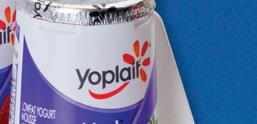














































P2PI.com
5
4 www.TrionOnline.com Toll-Free 800.444.4665 © 2020 Trion Industries, Inc. NON-COMPETITIVE VENDOR STATUS Since 1965 TRION® ONE SOURCE FOR ALL YOUR P.O.P NEEDS Shelf Management Multiple systems for every product, shelf type & retail environment. Display & Scan Hooks From the World’s Leading Manufacturer. Merchandising Tray Designed for yogurts, ice cream, cups, tubs & bottles, in dairy, frozen, center store & more. ® MerchandisingTray S N E E D S NEED AMT Adjustable MhdiiT ES Shelf Edge Labeling Over 450 label holder profiles & sizes for every need.
6
Best Buy again tied in to National Mario Day on March 10, which was created because “Mar10” is a clever play on “Mario” and celebrates the iconic Nintendo video game character and Super Mario franchise. For a week, the retailer offered savings on select Mario and Nintendo Switch items, while promoting the micro-holiday and savings across its website via dedicated ads linking to a branded landing page that highlighted an array of Mario-themed video games, accessories and toys.

7
Last August, 7-Eleven’s annual “Bring Your Own Cup (BYOC) Day” made its return to stores in 2022, after a two-year hiatus due to the COVID-19 pandemic. On Aug. 27, loyalty members could fill up the cup or creative container of their choice with their favorite Slurpee drink flavor for $1.99 at participating 7-Eleven, Stripes and Speedway locations.

8
Female-founded fashion brand Love, Bonito tied in to International Women’s Day on March 8 by placing 20 mirrors throughout New York’s SoHo neighborhood to inspire women to embrace self-love and reflection. Each mirror in the installation, which was only up for 24 hours, featured uplifting quotes, including one from Michelle Obama.

9
For a third year in a row, Hershey Co. brought back its limited-edition Hershey’s SHE bars with fresh packaging in honor of Women’s History Month in March and International Women’s Day on March 8. This year, the chocolate brand and its nonprofit partner Girls on the Run curated a list of 200plus powerful adjectives that describe impactful women and featured them on the SHE bars. Walmart elevated the offering and March 8 holiday via a dedicated brand shop within the retailer’s website.

50 l March/April 2023
Activation Gallery
7
6 8
9
Bob Evans Turns to Mobile Sampling
NEW CAULIFLOWER SKUS LAUNCHED AT KROGER BEFORE ROLLING OUT TO WALMART, MEIJER AND BEYOND.
BY ERIKA FLYNN
Bob Evans Farms launched a mobile sampling tour last year as part of a campaign driving awareness and trial of the manufacturer’s new mashed cauliflower assortment. Insights and consumer trends led the manufacturer to develop and launch Bob Evans mashed cauliflower in two flavors: “parmesan and chives” and “roasted garlic and herb.” Packaged in a microwavable dish and boasting about 2.5 full servings of vegetables, the SKUs launched exclusively at Kroger in mid-August before rolling out to Walmart and Meijer in mid-October. The dishes have since launched at more retailers, including Albertsons.
The brand built support for the new refrigerated dishes by staging a two-month “Taste Fest” mobile tour beginning in early October with stops in Cincinnati; Nashville, Tennessee; Columbus, Ohio; Grand Rapids, Michigan; and Bentonville, Arkansas. Kicking off on Oct. 7 at Kroger Fountain Square in Cincinnati, the tour included retailer parking lot events at two Kroger and two Meijer stores. Experiential agency Yum Love More handled the tour.
Cauliflower in all its forms has made its way onto 22% of American menus, says Tony Fung, director of shopper marketing and e-commerce at Bob Evans Farms. The vegetable has demonstrated its versatility as a side dish, starch replacement or center-of-plate item in place of meat proteins, he noted. Some consumers, however, don’t have the time or knowledge needed to cook with the vegetable.
“Consumers are looking for easy and fun ways to add more veggies to their diet,” Fung says. “However, they lack skills [or] know-how to prepare more veggies ... and available options are not delivering on taste and texture. As the market leader in refrigerated side dishes, our mashed cauliflower provides a full serving of veggies and is made with real milk and butter to satisfy even the most discerning taste.”
The target audience for the launch was consumers who prioritize serving more complete and wholesome meals — those who want fresh, tasty, time-saving solutions for a well-rounded weekday dinner plate.
Beyond the mobile tour, shopper marketing efforts included sampling of the mashed cauliflower products at the Kroger Wellness Festival last year. (Bob Evans Farms was a Ruby sponsor at the event.) “We had a branded Bob Evans Cauliflower tent, sampled parmesan and chives, and

distributed high-value coupons and swag to attendees over the event weekend,” Fung says.
Bob Evans additionally tapped the retailer’s media network, Kroger Precision Marketing, to run targeted on-site ads for four weeks in November. Incremental displays and a circular feature in August also promoted the new SKUs at Kroger. The broader marketing plan also included:
• Onsite and offsite digital banner ads via Walmart Connect promoting the cauliflower SKUs as well as Bob Evans core items (mashed potatoes and macaroni and cheese dishes).
• An in-store aisle violator and offers for mPerks members at Meijer starting mid-November to mid-December.
• Shelf signage and a digital coupon at Albertsons Cos. stores via Neptune Retail Solutions.
• National and geo-targeted banner ads from InMarket promoting the brand’s cauliflower and core items from December through July.
• Additional out-of-store elements, including linear and connected TV, and a mashed cauliflower billboard placed outside of Kroger, Meijer and Walmart headquarter locations. The Mars Agency is Bob Evans Farms’ shopper and e-commerce agency of record, responsible for all mashed cauliflower shopper marketing creative.
As far as success, Bob Evans is closely monitoring the velocity and volume of its mashed cauliflower in markets where the products are available, as well as measuring incremental sales and retailer acceptance.
Insider Intel P2PI.com
2023
WEBINAR TOPICS
Featuring special retailer guests in each episode, join us for a dialogue about current trends and strategies that are driving innovation for the next era of retail.
In partnership with Great Northern Instore, the Path to Purchase Institute invites you to listen in to a discussion with executives from today’s leading retail chains, emerging brands and parallel industries as we dive into the issues impacting the evolution of retail.
Attendees will:
•Hear firsthand retailer insights and experiences navigating successes and challenges in the market
•Discover how changing shopper behavior is reinventing retail across various segments
•Explore the shifting dynamics that will impact commerce marketing across all channels of the retail arena
Sign up now to gain insights, get inspired and go enact change at your own organization with the learnings from Retail Intel 2023.
VISIT P2PI.COM/RETAILINTEL2023 FOR MORE INFORMATION AND TO REGISTER. IN PARTNERSHIP WITH PRODUCED BY AN OFFICIAL EVENT OF ON LINE The Home Improvement Sector MAY 2 Experiential Retailing JUN E 6 Grocery Trends & Tactics AUGUST 23 Inside Beauty Retail SEPTEMBER 28 The Well-Being Movement DECEMBER 12 Retail Roundup
PLEASE


Storewide Merchandising Solutions American Ma nufacturing50 YEARS of YEARS of American Manufacturing OV ER








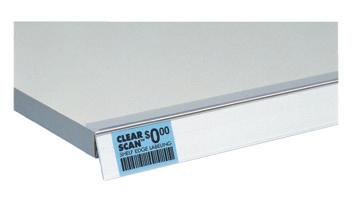







WonderBar ® Merchandiser For coolers, freezers and center store Clear Scan® AdjustaView ® Label System Auto-feed Tray System Pusher Hook and Display Hook Label & Sign Holder System Flip Scan® Hooks, Label Holders & Signing Accessories Glass, Wood & Solid Shelf Label Holders Glass, Wood & Solid Shelf Label Strips Wire Basket & Wire Shelf Label Strips Magnetic Pallet Rack Label Strips Electronic Ticket Label Strips & Holders Wire Basket & Wire Shelf Label Holders
WonderBar ® Trays

More ways to boost productivity
Mini Tray
n Made from U.S. steel and heavy-duty wire frames.
n Multiple-depths range from 13" to 24".

n Adjustable-widths adapt from 1 3/4" to 17 1/2".
Dual Lane Tray
Standard Tray with Finger Product Stop
n Tool-free installation.
n Bar and shelf capable.
n Auto feed any product.
Oversize Double-Wide Tray
Radius or Square Tray Sidewalls

Standard Tray with Locking, Molded Pusher


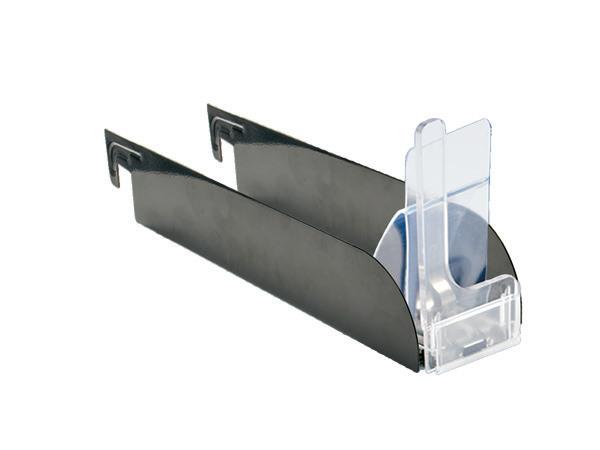
Create Exciting Cross-Sells

with Dual Lane merchandising
WonderBar® Dual Lane Trays

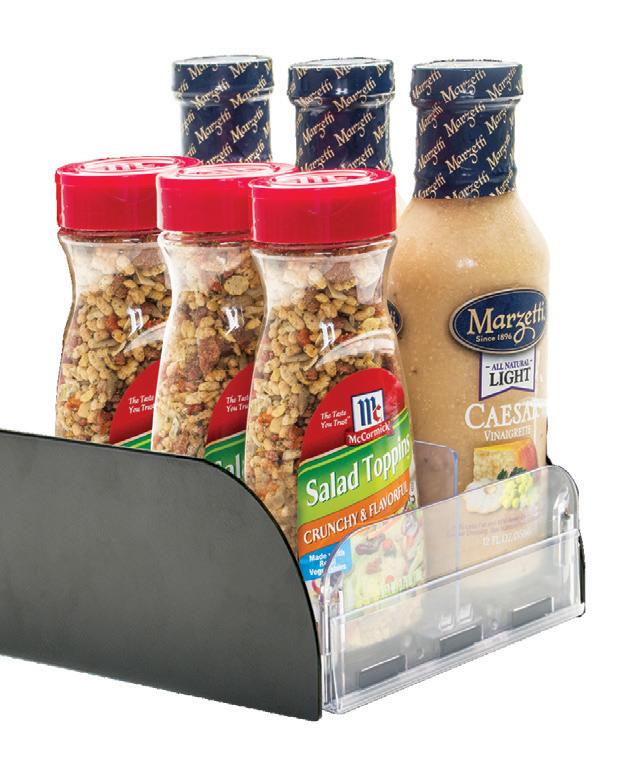
n Fit many more items, sell families of products in different sizes and increase impulse buying with cross-sells and adjacencies.
n Asymmetrical lanes sell different-width products.
n Each lane adjusts to fit products as small as 13/4" wide.
n Unique design features a separate paddle to push each item forward individually in its own lane.
Display Cheese & Salad
Improve rotation and reduce shrinkage

WonderBar® Trays
n Face more packages, accommodate a wider range of shapes and sizes, restock easily, and manage dated produce better.

n Air baffles maintain product temperature and extend shelf life.
n Durable cooler-capable steel construction ensures long life.
n Trays lift out for rear restocking and proper rotation.
n Versatile spring tension is gentle on delicate produce.
Cooler-Capable EWT ™

Expandable Wire Tray for refrigerated retail

n Quick drop-on, one-piece installation.
n Accommodates any style or size package adjusting from 3 3/8" to 17 1/2" lane width.
n Various built-in mounting capabilities available based on shelf component.

n Molded pusher paddle available, both locking and non-locking styles with wire- or metal-sided trays.
n Auto feed any product.
n Clear or Imprinted Front Product Stops.
n Vends oversize items like pizza.
Display & Scan Hooks
Hooks for every purpose
Right Angle Label Holder Hook


n A simple, inexpensive design.

n Use with Quick Back® to maximize product density, provide easy mounting and relocation of stocked hooks in tight places, under shelves or in fully loaded displays, and speed re-merchandising and display changeover.
Economical All Wire Hook
n Safer, rounded Ball-End Tips are available on all hooks at no extra charge and no minimum order.
n Use the Peg Hook Overlay to quickly convert All Wire Hooks to Scan Hooks.
Slatwall Hooks
Pouch Hook™ Merchandising
A new venue of product promotion
Pouch Hook™ Merchandising
n Standard and Gravity-Feed options keep items forwarded and automatically faced.

n Tool-free installation on most common gondola and cooler uprights.
n Stocked in 4 lengths compatible with all standard shelf sizes allowing mixed use in display.
Flip-front Label Holder swings up for easy access and product removal.



Protect Your Merchandise
Anti-theft security hooks
Scan Lock® Hooks
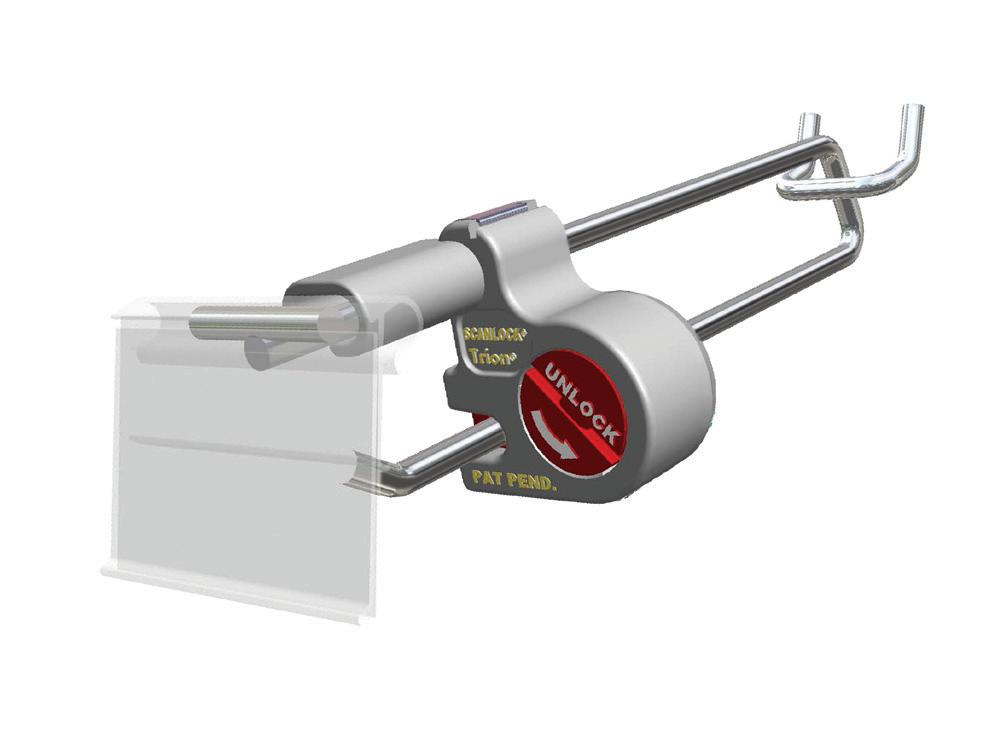
n Easy-to-use, inexpensive key-lock system.

n Prevent the removal of any stock or display 1 or 2 items unlocked to prevent sweeping.
Anti-Sweep™ Hooks
n Camel-back profile prevents sweeping while providing direct access for customers.

n Flip Scan® Label Holder swings up and out of the way.
n Use of plain-paper labels can save up to 65% on labels and up to 75% on labor.

Adjustable Merchandising Tray®
AMT ® for dairy, freezer and center store

n Molded-in openings improve refrigeration air circulation.
n Top-tier sidewall available for support and containment of tall or multi-tier products.
n Adjustable width trays, designed for yogurts, ice cream, and other difficult to organize products.
n Trays lift out with easy-grip handles to allow quick restocking or cleaning.

Clear Scan® Label Holders

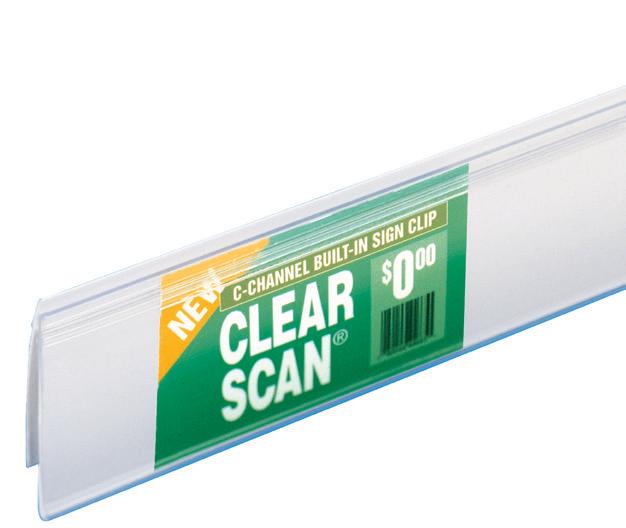

The complete shelf edge labeling system
n Easy-to-use design flexes open at a touch for fast, drop-in, plain-paper labeling, then automatically springs shut to secure the label in place.
n Unsurpassed range of sizes, styles & lengths.
n Labels shielded from dirt, spills, moisture & wear so they last longer, read easier & scan more accurately.
n Long lasting PVC construction retains “memory” and shape, resists yellowing, darkening & aging.
 Choice of magnetic, adhesive or clip-on mounting systems.
Choice of magnetic, adhesive or clip-on mounting systems.

Being Seen Means Being Sold® ©2022 Trion Industries, Inc. 297 Laird St., Wilkes-Barre, PA 18702 Ph 570-824-1000 | Fx 570-823-4080 Toll-Free in the U.S.A. 800-444-4665 info@triononline.com www.TrionOnline.com American Ma nufacturing50 YEARS of YEARS of American Manufacturing OV ER







































































































































































































































































































